

The United States SPECIALIST



John Walter Scott: The Father of American Philately





Encyclopedia of United States Stamps and Stamp Collecting Second Edition
Edited by Rodney A. Juell, Lynn R. Batdorf and Steven J. Rod
Hardbound, 769 pages. $35 members, $40 nonmembers. Visit the website for shipping costs.

United States Savings Stamps by Harry K. Charles, Jr.
A presentation of the United States Postal and Treasury Savings Stamp Systems, the stamps and their closely associated collection cards and booklets, and Official Mail stamps and stationery.
Softbound, 253 pages.
Postpaid: $25 members, $28 nonmembers. Visit the website for shipping costs.
Order from: USSS, P.O. Box 1602, Hockessin, DE 19707-5602 or online at: www.usstamps.org/store/

The United States SPECIALIST
the journal of the United States Stamp Society
VOLUME 96, NUMBER 8 AUgUst 2025
WHOLE NUMBER 1146
An association of collectors to promote the study of all postage and revenue stamps and stamped paper of the United States and US-administered areas produced by the Bureau of Engraving and Printing and other contract printers. American Philatelic Society Affiliate No. 150
Prologue
360 Vintage Photo of the Month by Rodney A. Juell

Epilogue
381 Plate Number Report by Kim D. Johnson
Executive Secretary’s Report by Robert Rufe
Index of Advertisers
Andrew S. Kelley, Editor 9038 East 25th Drive Denver, CO 80238 (720) 839-5848
email: editor@usstamps.org www.usstamps.org
Manuscripts, publications for review, and all advertising including classifieds, should be sent to the Editor at the address above.
Forms close on the 20th of the second month preceding the month of publication, as February 20 for the April edition.
The United States Specialist (ISSN 0164-923X) is published monthly January through December by
Features
305 Great Americans Issue Part XV— 1994–95 Issues by Jay Stotts
348 FDR, Farley and the 1933 Newburgh Peace Stamp by Paul M. Holland


362 Re-Registered After Delivery Frankfurt, Germany to New York to Shanghai and Back by Roger S. Brody
367 An Homage to a Forgotten Alaskan Aerophilatelist by Michael L. Wilson
371 John Walter Scott: The Father of American Philately by Chris King
the United States Stamp Society, Inc., P.O. Box 1602, Hockessin, DE 19707-5602. Membership in the United States $25. North America $40; all others $65. Single copy $2. Periodical postage paid at Hockessin, DE, and at additional entry offices. Printed in USA.
Copyright ©2025 United States Stamp Society, Inc. All rights reserved. Opinions expressed by authors are their own and do not necessarily reflect those of the United States Stamp Society, its officers, or staff.
Correspondence concerning business affairs of the Society, including membership and changes in address, should be addressed to the Executive Secretary, PO Box 1602, Hockessin, DE 19707-5602.
Postmaster: Send address changes to U.S.S.S., P.O. Box 1602, Hockessin, DE 19707-5602.

The United States Specialist
Founded 1930 as The Bureau Specialist
EDITOR
ANDREW S. KELLEY
9038 East 25th Drive Denver, CO 80238 email: editor@usstamps.org
United States Stamp Society Bureau Issues Association, Inc.
P.O. Box 1602 Hockessin, DE 19707-5602
CHAIRMAN
Roger S. Brody
P.O. Box 5836 Somerset, NJ 08875-5836 email: brody@usstamps.org
PRESIDENT
Nicholas Lombardi
P.O. Box 1005 Mountainside, NJ 07092 email: 8605@comcast.net
VICE PRESIDENT
Jeffrey Shapiro
P.O. Box 3211 Fayville, MA 01745-3211 email: coverlover@gmail.com
SECRETARY
Joel Cohen
10703 Kings Riding Way, Unit T-1 Rockville, MD 20852-5420 email: cohenji@comcast.net
TREASURER
David S. Sugar 4045 N. Harvard Ave. Arlington Heights, IL 60004 email: david-sugar@wsdd.com
GOVERNORS
Lynn Batdorf
Kim Johnson
Mike Lampson
Leonard Piszkiewicz
James Robinson
Robert Rose
Rod Juell
Gregory Shoults
David Steidley
Jay Stotts
Steven Unkrich
EXECUTIVE
SECRETARY
Robert Rufe
P.O. Box 1602
Hockessin, DE 19707-5602 email: execsecretary@usstamps.org
— Committees — AWARDS
Denise Stotts
email: stottsjd@swbell.net
BOOKLETS & BOOKLET PANES
Michael O. Perry
P.O. Box 1194, Rainier, OR 97048 email: MOPerry@mac.com
DURLAND EDITOR
Kim D. Johnson
310 E N 3rd Street, Georgetown, IL 61846 email: westhome1@aol.com
ESSAY-PROOF
James Patterson
1850 North Central Avenue, No. 1400 Phoenix, AZ 85004 email: jhpatterson@yahoo.com
EXHIBIT PDFs
Chris Steenerson
P.O. Box 1818
Westminster, CO 80038-1818
email: Chris@RxStamps.com
FARLEY ERA
Paul M. Holland
email: pholland.thorleaf@gmail.com
FOURTH BUREAU ISSUE
Jay B. Stotts email: stottsjd@swbell.net
LIBERTY SERIES
Roland Austin P.O. Box 2641, Stillwater, OK 74076-2641 email: RAustin13@aol.com
MARGINAL MARKINGS
Chris Steenerson P.O. Box 1818 Westminster, CO 80038-1818 email: Chris@RxStamps.com
MODERN POSTAL HISTORY
Douglas B. Quine P.O. Box 153, Bethel, CT 06801-0153 email: usss2010@quine.org
PLATE NUMBER & CHECKLIST SERVICE
Kim D. Johnson
310 E N 3rd Street, Georgetown, IL 61846 email: westhome1@aol.com
PRECANCELS
Lynn R. Batdorf 6005 Kingsford Road, Bethesda, MD 20817 email: hollykids@comcast.net
PRESIDENTIAL ERA
Jeffrey Shapiro P.O. Box 3211, Fayville, MA 01745-3211
RECRUITING
Steven Crippe PO Box 117001, Carrollton, TX 75011 email: scrippe@gmail.com
REVENUE ISSUES
Peter Martin
P.O. Box 6074, Fredericksburg, VA 22403 email: pmartin2525@yahoo.com
SECOND BUREAU ISSUE
Nicholas Lombardi
P.O. Box 1005, Mountainside, NJ 07092
VENDING AND AFFIXING MACHINE PERFORATIONS
Dan Ryterband 40 Carolyn Place, Chappaqua, NY 10514 email: djryterband@fwcook.com
WASHINGTON-FRANKLIN
HEAD ISSUES (Co-Chairmen)
Greg Shoults 11248 Frederick Lane Twinsburg, OH 44087 email: coilcollector@hotmail.com
Andrew S. Kelley 9038 E 25th Dr, Denver, CO 80238 email: stamps@andrewkelley.net
WEBMASTER
Mike Lampson
P.O. Box 471963, Charlotte, NC 28247 email: lampson@usstamps.org
— Study Groups — DUMMY STAMPS
Terry R. Scott
P.O. Box 10406, Napa, CA 94581 email: terryrscott@comcast.net
FIRST BUREAU ISSUE [open]
LUMINESCENCE
Wayne L. Youngblood 705 Forest Glen Circle, Prairie du Sac WI 53578 email: wystamps@gmail.com
OVERRUN COUNTRIES SERIES
Thomas Schilling
P.O. Box 432, New Lisbon, NJ 08064-0432 email: cbtkschilling@yahoo.com
PROMINENT AMERICANS AND AMERICANA SERIES
Ron Blanks
P.O. Box 9282, Chesapeake VA 23321 email: rblanks_stamps@yahoo.com
REGISTERED MAIL
Mike Ludeman
P.O. Box 2024, Denton, Texas 76202-2024 email: mike@ludeman.net
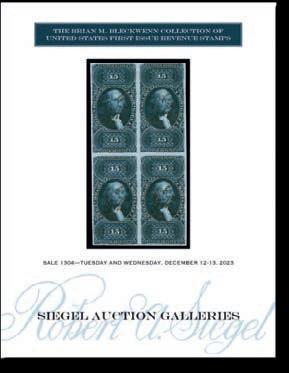


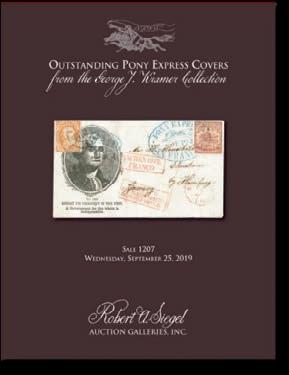


Siegel offers unparalleled expertise, a worldwide client base, financial reliability, intelligent marketing, and the best internet resources of any philatelic auction house. Contact us today to learn more about consigning with Siegel and ensuring your legacy.

21 West 38th Street, 7th Floor
Phone (212) 753-6421
Email: stamps@siegelauctions.com

Great Americans Issue Part XV—
1994–95 Issues
by Jay Stotts USSS #10921 | m stottsjd@swbell.net

The United States Postal Service (USPS) switched to another private sector contractor to print the only Great Americans (GA) issue released in 1994. The 1994 stamp, the 20¢ Virginia Apgar stamp, was printed by The Banknote Corporation of America (BCA), with headquarters in Chantilly, North Carolina.
The 20¢ Virginia Apgar Stamp
Previously, three different subjects had appeared on GA 20¢ stamps, so Virginia Apgar became the fourth different 20¢ subject. The stamp was issued on October 24, 1994, in Dallas, Texas, and honored the noted anesthesiologist who developed the noted Apgar Score for determining the immediate health of newborns worldwide. The Apgar stamp is shown in Figure 1. The domestic post card rate increased from 19¢ to 20¢ effective on January 1, 1995, so there was reason to develop yet another 20¢ Great American stamp. The USPS project manager and art director for this stamp, Joe Brockert, commented, “We decided it was time to retire Mr. Truman rather than create yet another variety of his stamp.”
The Great Americans
Figure 1. Virginia Apgar stamp.
Figure 2 shows the USPS publicity photo for the stamp’s upcoming release, and one can easily see that it looks quite different from the stamp as issued and shown in Figure 1. The design for the stamp was around since 1991 and was prepared by Robert Anderson of Massachusetts. Anderson used a dark background as a contrast with Apgar’s white hair. Other than her name, all other lettering was white to contrast with the background.
The printer, BCA , suggested that the white lettering would not work well on such a small scale and provided photographic models at stamp dimensions to prove their point. USPS officials agreed, and the design was changed.
The stamps were printed on a sheet-fed press known as a T/A-2.
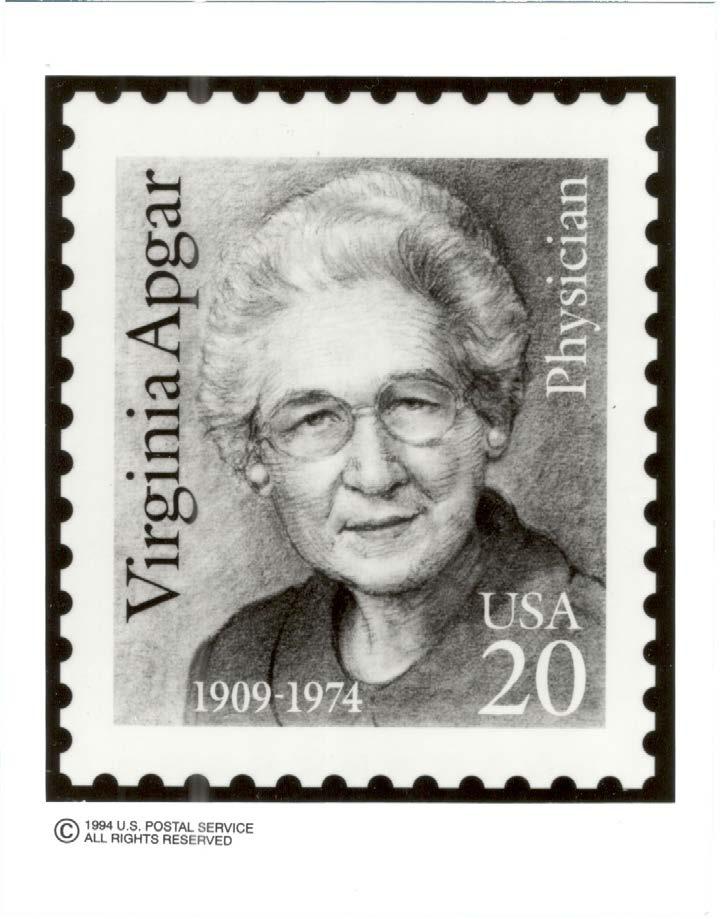
The printing plates were engraved in the flat position and then curved to fit the printing drum. The printing was done in the BCA facility in Suffern, New York. Some accounts differ, but we believe that these were 800-subject plates, printing eight counter panes at a time.
The Postal Service standardized marginal markings starting in 1994, and the Apgar was the first Great Americans stamp to conform to the new standard. The type size was significantly reduced, including the plate number. The first Apgar plate was designated B1 (the B designates BCA as the printer.) Other marginal markings include a multiplication formula to indicate the value of a total pane of stamps (20 × 100 = $20.00) and a copyright designation. Mr. ZIP is not present. The plate number appears in the corner of a pane. Figure 3 shows a plate block printed from plate B1.
The BCA reported that 518,132 impressions were printed from plate B1 before it was damaged, so a new plate, plate B2, was created, and 109,368 impressions were made before the first press run was completed. Figure 4 shows a B2 plate block.
Perforations were added, according to BCA , by a Model BPA 9070 stroke perforator manufactured by Wista. We understand that this was a comb-style perforator.
By January 1995, specialists were reporting two paper types that had been used during the Apgar press run. They reported both paper types associated with both plate numbers, which is quite possible considering this was a sheet-fed press, not a web-fed press. These papers were prephosphored. One paper is described as yellowish appearing in daylight with prephosphoring that appears almost solid but is slightly mottled. The
Figure 2. Apgar publicity photo.


other paper is described as white, appearing in daylight with a mottled-appearing prephosphor taggant. These specialists concluded that the difference in appearance was not really in the short-wave phosphors, but in the brightness of the paper.
By March 1996, Linn’s Stamp News ran an article announcing that the next issue of the Scott Specialized Catalogue of United States Stamps would list a dark brown shade of the Apgar stamp. The stamp color was called brown by original USPS press releases, but Scott listed the color as red-brown under number 2179 in the catalog. The article reported the darker color as coming from printings from plate B2.
The article states, “Apgar stamps also exist in various hues between red-brown and dark red-brown, making identification of the dark red-brown variety difficult when only a few examples of the Apgar stamp are at hand.” Currently, (2024) the Scott catalog lists three color shades: 2179 (red brown), 2179a (orange brown) and 2179b (bright red brown). They make no effort, in their listing, to attribute the three color shade to specific printings, so collectors often struggle to align copies of their stamps with the three specific Scott color listings.
In 1997, BCA made a reprint of the 20¢ Apgar stamp. A new sleeve (as opposed to the previous two curved plates) was created and numbered B3. The sleeve was made for an Italian-made press, known as the Epikos Press, most likely located in a BCA facility in Browns Summit, North Carolina. This press printed on a web or roll of paper rather than on individual sheets.
The marginal markings were changed between B3 printed panes and B1 and B2 printed panes. B3 panes have two plate blocks rather than one and show a plate position diagram. Text of the copyright and the multiplication formula were rotated, so multiples containing marginal markings can be easily identified as reprints or original prints. Figure 5 shows two two blocks of ten stamps pieced together to illustrate the marginal markings from sleeve B3.
The Wista perforator was used for this printing, but, probably because this was a web-fed printing, perforations were not extended through the right margin selvage.
Linn’s Stamp News, in the June 2, 1997, issue, ran a column comparing the reprint to the original stamp. “Linn’s has examined a block of four of the stamps and found them to
Figure 3. Apgar B1 plate block.
Figure 4. Apgar B2 plate block.

be basically identical to previous Apgar stamps in general color, gum, perforation gauge, paper and taggant,” they commented, but two paragraphs later, added, “Color, of course, is another matter with the Apgar stamp. It is known in red-brown and brown, with numerous in-between shades.” As stated earlier, Scott now also lists an orange brown shade.
Stephen Esrati, in summarizing the reprint, reports that B3 printings show, “Dead paper with greenish (grainy solid) prephosphoring. Ink appears red in long-wave UV.”
Collectors can expand their interest to the limit with this stamp. It appears that varieties of paper and ink hues, three different Scott catalog listings, and a couple of marginal markings practices will make this issue a bane among Great Americans collectors.
The 55¢ Alice Hamilton Stamp
Another physician followed Virginia Apgar as the next Great Americans issue. Dr. Alice Hamilton, a social reformer, educator and founder of occupational health, was honored on a 55¢ stamp, meeting the twoounce domestic first-class letter rate at the time of issue on July 11, 1995. A plate block from plate B1 is shown in Figure 6.
The Hamilton stamp was the first to feature two plate blocks on a pane of 100 stamps. A plate block appeared on both the upper and lower wide marginal selvage corners of the pane. This was adopted on the Apgar reprint as described earlier.
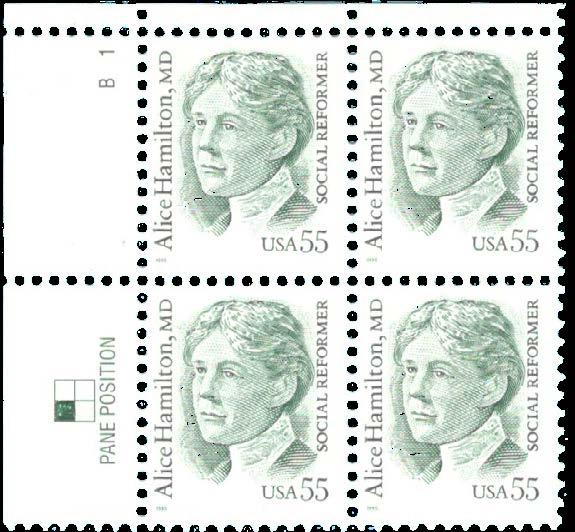
The Hamilton stamp was printed by the Banknote Corporation of American on one or more of their T/A-2 sheet fed presses. This printing was done in Browns Summit, North Carolina. The stamps were issued in post office panes of 100 stamps. The stamp was designed by Great Americans veteran Chris Calle of Connecticut and was issued in Boston.
The BCA noted that 370,000 net impressions were produced from plate B1 (to press on May 5, 1995) before a second plate, B2, went to press on May 13, with 130,000 net impressions. These stamps were printed on prephosphored uncoated paper, so the embedded taggant will appear grainy. They have a low-gloss gum.
Perforation was the same as described for the Apgar stamp. The Wista device was a comb perforator that advanced by one row per punch iteration as the stamps advanced
Figure 5. Marginal markings from sleeve B3 of the 1997 Apgar reprint.
Figure 6. Hamilton B1 plate block.
sideways through the machine. Figure 7 shows an illustration from an auction catalog that illustrates a spectacular perforating error. Here, the last strikes of the comb perforator, as it advanced from the right to the left, were not completed, creating imperforate errors. Scott lists this error, but does not price it. The auction reported that this piece represented five of 20 known imperforate pairs.

Like the Apgar stamp, the Hamilton stamp was reprinted on the BCA’s Epikos webfed press. Sleeve number B3 was assigned. Esrati reported that a different, heat-set ink was used on the reprint. One would expect that this ink change would impact the perceived color hue, but it appears almost identical (possibly lighter) under Ott lighting. Scott does not list color shades on this issue.
For those of you who search for more in-depth information on the Hamilton stamp, you may run across articles written on perforation hole size (large versus small) using Hamilton stamps as a comparison illustration. Per the explanation of the author, these are simply the result of variations in the wear and rehabilitation of female perforating pin receptacles during routine perforating. Perforation hole size varies continuously, , and it is up to the specialist if they want to collect examples representing the extremes of the infinite variations.
78¢ Alice Paul Stamp
The third BCA stamp that this article will address is the Alice Paul stamp, released on August 18, 1995, in Mount Laurel, New Jersey. Paul was a suffragist, fighting for women’s
Figure 7. Hamilton imperforate errors.
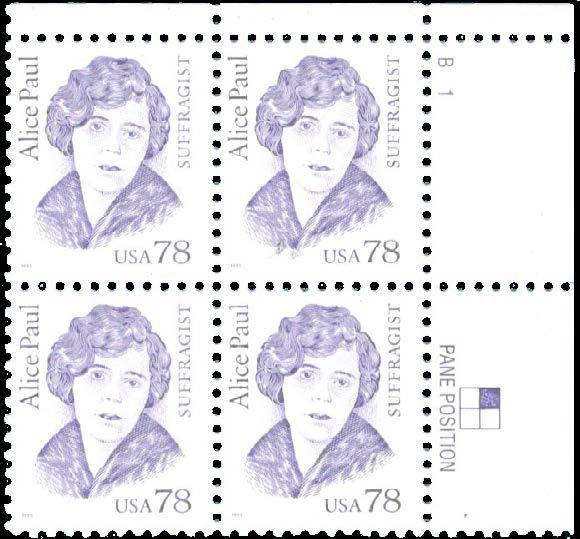
rights throughout her life. The 78¢ value matched the rate for a domestic first-class letter weighing between two and three ounces.
This stamp was also printed on a sheetfed BCA T/A-2 sheet-fed press. Initial printings used plate B1. Figure 8 shows a plate block from plate B1. After plate B1 had become worn, it was removed from the press and replaced with plate B2.
Students of this stamp will quickly point out that the Paul stamps provide a spectacular range of color hues. Scott lists three colors: 2943 (bright purple), 2943a (dull violet), and 2943b (pale violet).
The first listing, Scott 2943, bright purple, is attributed to printings from plates B1 and B2. These stamps have dull gum and taggant that appears uniform. Stephen Esrati reported that British-made paper from Coated Papers Ltd. was used to produce this shade.
Esrati reported that a change to American-made paper from Westvaco produced the dull violet shade. This shade appeared in the spring of 1996 and has shiny gum. The surface taggant appears grainy under short-wave ultraviolet light.
Once the worn chrome plating was removed and the plate was re-chromed, plate B1 was restored to printing duty. At a still later date, B2 was returned to press, being united with the American paper.
To further complicate the colors and paper issue, the marginal markings were altered between plate 1 and plate 2. Both plates had plate numbers in the top and bottom corners on the wide selvage edges. The plate diagram schematic is in different positions, as is



Figure 8. Alice Paul B1 plate block.
Figure 9a. Bright violet.
Figure 9b. Dull violet.
Figure 9c. Pale violet.
the copyright notation. Plate B1 has USPS promotional advertising. Plate B2 has a pane value multiplication formula.
The third listed shade, Scott 2943b (pale purple), was reported from plate B2 in the spring of 1998. The color resulted from an ink change. The new ink was described as an ink that fluoresces pink under long-wave ultraviolet light. This printing is on American paper. Unlike the Apgar color variations, the Paul colors are much easier to distinguish visually. Figure 9 shows an overlay of the three Scott-listed color shades.
Definitive-Sized Commemoratives to Come
Although this segment was titled 1994–95 Issues, we’ll delay the discussion of the 1995 issued 32¢ Milton Hershey stamp until Part XVI to include it with three other 32¢ Great Americans, all issued to meet the domestic letter rate and all once called, “downsized, cut-rate commemoratives” by philatelic author Fred Baumann.
Quality United States Stamps (1847-1945)
Singles (mint and used)
Plate Blocks
Booklet Panes plus Complete Booklets
Price lists-$2.00 each category
Price lists free on web: www.mountainsidestampsandcoins.com

We also buy quality U.S. and foreign stamps
Mountainside Stamps, Coins and Currency
P. O. Box 1116
Mountainside, NJ 07092
Tel: 908-232-0539 or 908-419-9751
E-mail: tjacks@verizon.net
Tom Jacks, owner Member APS, ASDA, USSS
USatFACE.com
If you collect Plate Blocks, Booklets, Coils, or Sheets, the above website, with hundreds of sets at Face Value, will be a great savings to you. Enjoy the hobby.

Armen Hovsepian (APS 150170)
P. O. Box 24222

Overland Park, KS 66283 info@USatFACE.com










by Paul M. Holland USSS #16849 | m pholland.thorleaf@gmail.com

The stamp attached to this envelope is one of the first Proclamation of Peace commemorative stamps sold and dispatched from Newburgh, New York, today.
It is fitting that the first new postage stamp issued under the authority of the administration of President Roosevelt marks one of the closing chapters in the War for Independence, the first formal ending of hostilities.
It was from the old Hasbrouck House at Newburgh, which is depicted on this stamp, that General Washington penned that historic document proclaiming peace between the Armies of the Colonies and Great Britain. This famous revolutionary shrine is still standing, and the building and surrounding park are now owned by the State of New York.
From the viewpoint of the historical record, it is appropriate, therefore, that the first day sale of the new stamps should be at Newburgh, New York, where this memorable drama was enacted, one hundred and fifty years ago today.
FDR, Farley and the 1933 Newburgh Peace Stamp ”
—From a signed April 19, 1933, letter sent with a Favor First Day Cover of the 3¢ Newburgh Peace Stamp sent to Rep. Fred J. Sissson, Congressman from New York, by Postmaster General James A. Farley
Lindbergh Airmail Stamp
The Newburgh Peace commemorative was the first stamp issued under the newly inaugurated President Franklin D. Roosevelt (FDR) administration. Although this was at the depths of the Great Depression, it also marked the beginning of a fresh new era for stamp collectors and stamp collecting in the United States. As the Postmaster General (PMG) for an ardent philatelist, James A. Farley became unusually well tuned to the needs and preferences of stamp collectors. Of particular interest to me, the Newburgh Peace stamp led Farley to begin the novel practice of writing and signing an official letter describing each new stamp and the circumstances for issuing it, then sending it out with a favor first day cover (FDC) on official PMG stationery to a favored few. For philatelists today, these signed official letters provide a valuable inside look at the thinking behind the stamp by the Post Office Department “straight from the horse’s mouth.” Furthermore, the issuance of the Newburgh Peace commemorative stamp also inaugurated FDR’s practice of purchasing a full sheet (pane) of each new stamp when issued and then signing it, typically with his Secretary of the Treasury, Henry Morgenthau, Jr. and then preserving this as a memento in his personal stamp collection.
The origins of the Newburgh Peace commemorative stamp curiously began with a recommendation by New York Congressman Hamilton Fish to President Hoover’s Postmaster General (PMG) Brown, that the 150th anniversary of George Washington’s proclamation of peace issued from his headquarters in Newburgh, New York, on April 19, 1783, be commemorated. Although in favor of such a stamp, PMG Brown suggested that, because of the transition to the new Franklin D. Roosevelt (FDR) administration, this should also be taken up with incoming PMG James A. Farley. Not waiting for FDR’s inauguration, Rep. Fish directly approached President-elect Roosevelt, who, being an ardent stamp collector, immediately expressed his approval for this suggestion.1
Washington’s headquarters at Newburgh, New York, is depicted on the hand colored Currier & Ives print shown in Figure 1. This peaceful setting, showing Hasbrouck House on the Hudson River, became a central feature in the design of the new stamp.

Figure 1. Currier & Ives print of Washington’s headquarters at Newburgh in 1780 (courtesy of the Library of Congress).
There are numerous variants of this peaceful scene, and according to Max Johl, it was an engraving by James Smillie that became the basis for design work at the Bureau of Engraving and Printing (BEP). Based on a painting by Robert Walter Weir, this was published in the New York Mirror in 1834 and is shown in Figure 2.1 Note the precise match of the surrounding vegetation that frames the scene on the final stamp.
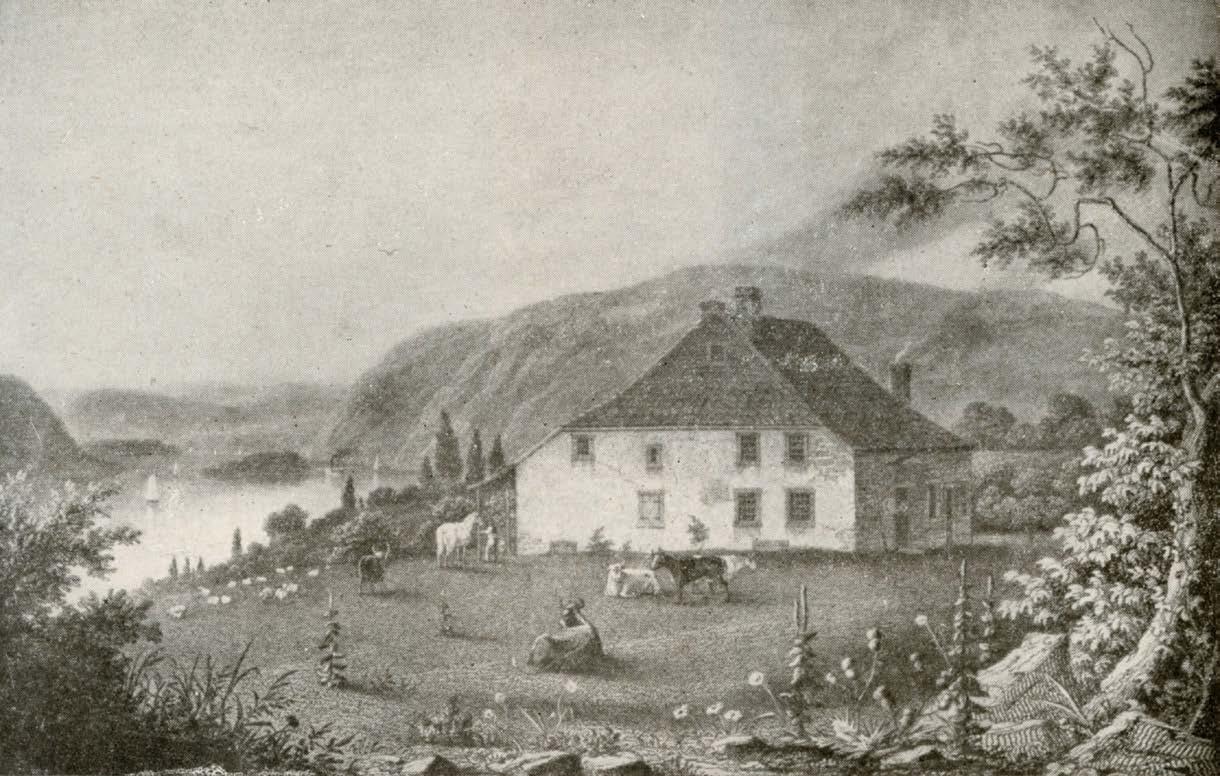
On March 10, 1933, only a few days after FDR’s inauguration, PMG Farley announced that “with the personal approval of President Roosevelt, who is an enthusiastic stamp collector, he has directed the issuance of a special stamp to commemorate the 150th anniversary of the issuance of the Proclamation of Peace, at Newburgh, N. Y., April 19, 1783.”1
Essays for the stamp were prepared by three different artists at the BEP, with various rejected designs shown in Figure 3. The two on the left are by C. A. Huston, the one on the right by Victor M. McCloskey, who also produced a variant without stars (not shown).1 Note the presence of both American and British flags or banners on two of

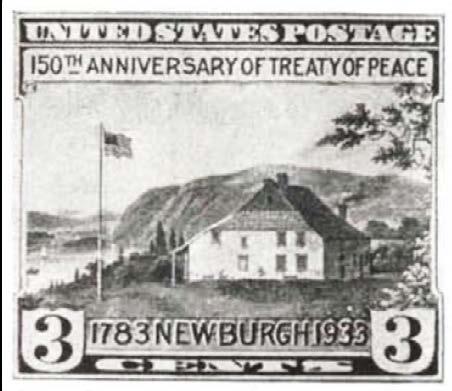

Figure 2. Engraving of Hasbrouck House on the Hudson River from the New York Mirror in 1834.1
Figure 3. Essays for Newburgh Peace commemorative stamp.1
the rejected designs, with the words “150th Anniversary of Treaty of Peace” or “Peace Treaty” on all of them.
The approved design by A. R. Meissner, instead, simply uses the wording “Washington’s Headquarters, Newburgh, N.Y. 1783–1933.” The die was engraved by L. S. Schofield (vignette) with frame and lettering by E. M. Hall and W. B. Wells.1 Of special interest is a series of progressive die proofs now in the collection at the National Postal Museum that illustrate how this engraving was executed. Remarkably, these large die proofs (the only ones known) came from FDR’s own stamp collection.2 The first of these, shown in Figure 4, reveals that the lettering was engraved onto the die first, employing a series of fine, shallow lines to ensure precise alignment. These shallow lines were then polished (erased) from the surface of the die before proceeding with the engraving of the vignette and frame as shown in the series of close-up images of the die progression in Figure 5. The final step included engraving lines for shading the sky and the Hudson River, as shown in my example of the issued stamp.
The die proof was approved by PMG Farley on March 28, with the first plate proof (shown in Figure 6) certified on April 11, 1933. Note the gutters between panes on the full sheet of 400 stamps on the plate proof.
Printing began that same day at the BEP. Since this was the first stamp to be issued under the new Roosevelt administration, there was a special ceremony. Here, Postmaster General Farley OKed the first sheet of stamps coming off the rotary press in the presence of Alvin W. Hall, Director of the Bureau of Engraving and Printing, as shown in Figure 7. Note that when the stamps were signed by Farley they were still imperforate.

Figure 4. First of ex-FDR progressive die proofs (courtesy Smithsonian National Postal Museum).


5.


of ex-FDR progressive die proofs with the final stamp (courtesy Smithsonian National Postal Museum and author’s collection).
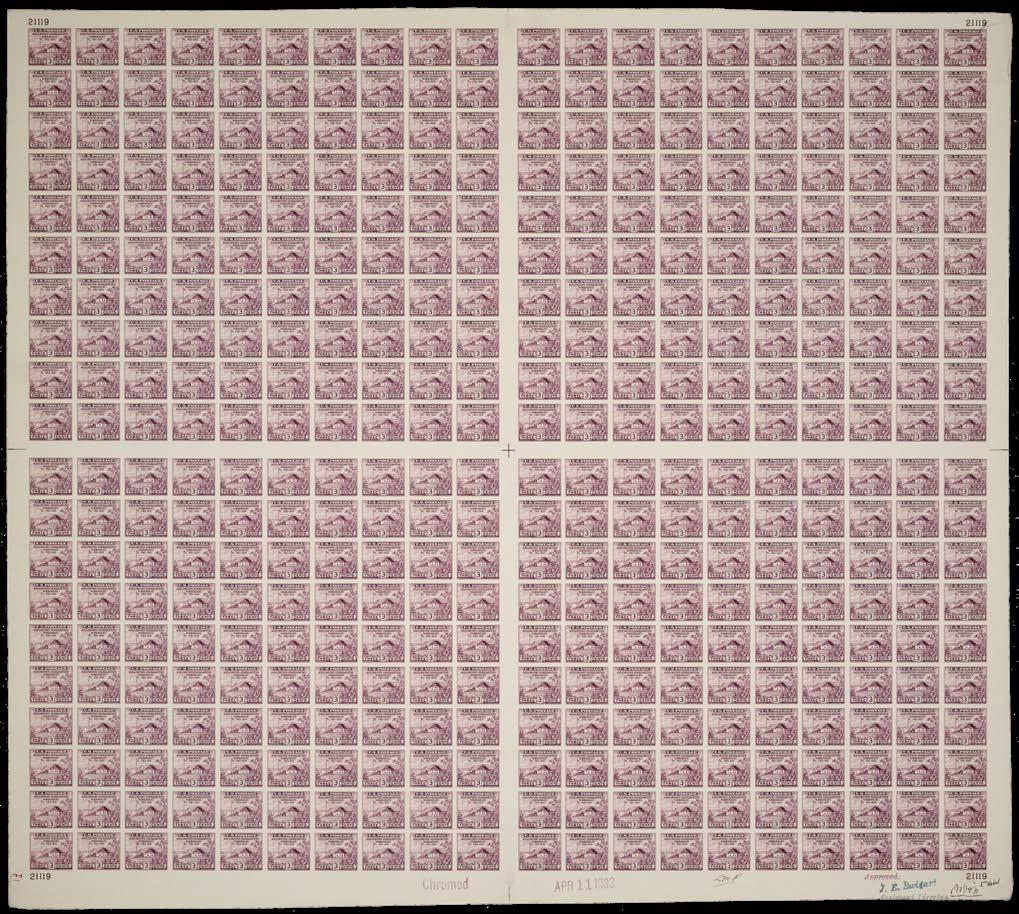
Figure
Close-ups
Figure 6. Plate proof for Newburgh Peace stamp (courtesy Smithsonian National Postal Museum).
Because there was no intention at the time to create a “special type issue” they were then perforated but not gummed. This original sheet, signed by Farley in crayon, is now in the National Postal Museum (Figure 8).

7. PMG Farley signing the first sheet of the Newburgh stamps as it came off the press in the presence of A. W. Hall, the BEP’s director.

Figure
Figure 8. First sheet of Newburgh Peace stamp (courtesy Smithsonian National Postal Museum).
During this same ceremony, PMG Farley also signed other full sheets of the Newburgh stamps across the middle of the sheet in black crayon. This included one for FDR inscribed “For President Franklin D. Roosevelt For Collection, James A. Farley, P.M.G. 4/11/33.”2 Another was signed for his wife and children, Betty, Ann, and Jimmy. Later donated to the Smithsonian along with many other Farley items, this sheet is shown in Figure 9.

As a long-time collector of favor first day covers (FDCs) on official Postmaster General stationery with enclosed signed letters, I was especially pleased to acquire the example shown in Figure 10. This item, with its signed letter, had been especially elusive. It’s interesting to note that besides the envelope’s embossed PMG corner card, there is a large (two inch) embossed Post Office Department seal that has been applied on the left side. Note also that the addressee is New York Congressman Fred J. Sisson, a Democrat whom Farley knew well.
As mentioned previously, with the Newburgh Peace commemorative stamp, FDR began the practice of purchasing a full sheet (pane) of each new stamp for his personal stamp collection when issued. He then signed it and typically got Henry Morgenthau, Jr., his Secretary of the Treasury, also to sign it. Fortuitously, the pane for the Newburgh Peace stamp is now in the Franklin D. Roosevelt Presidential Library and Museum. This is shown in Figure 11. I’m fortunate in having a similar FDR signed sheet for the 1935 Connecticut Tercentenary stamp.3
Figure 9. Farley signed sheet of Newburgh Peace stamp (courtesy Smithsonian National Postal Museum).
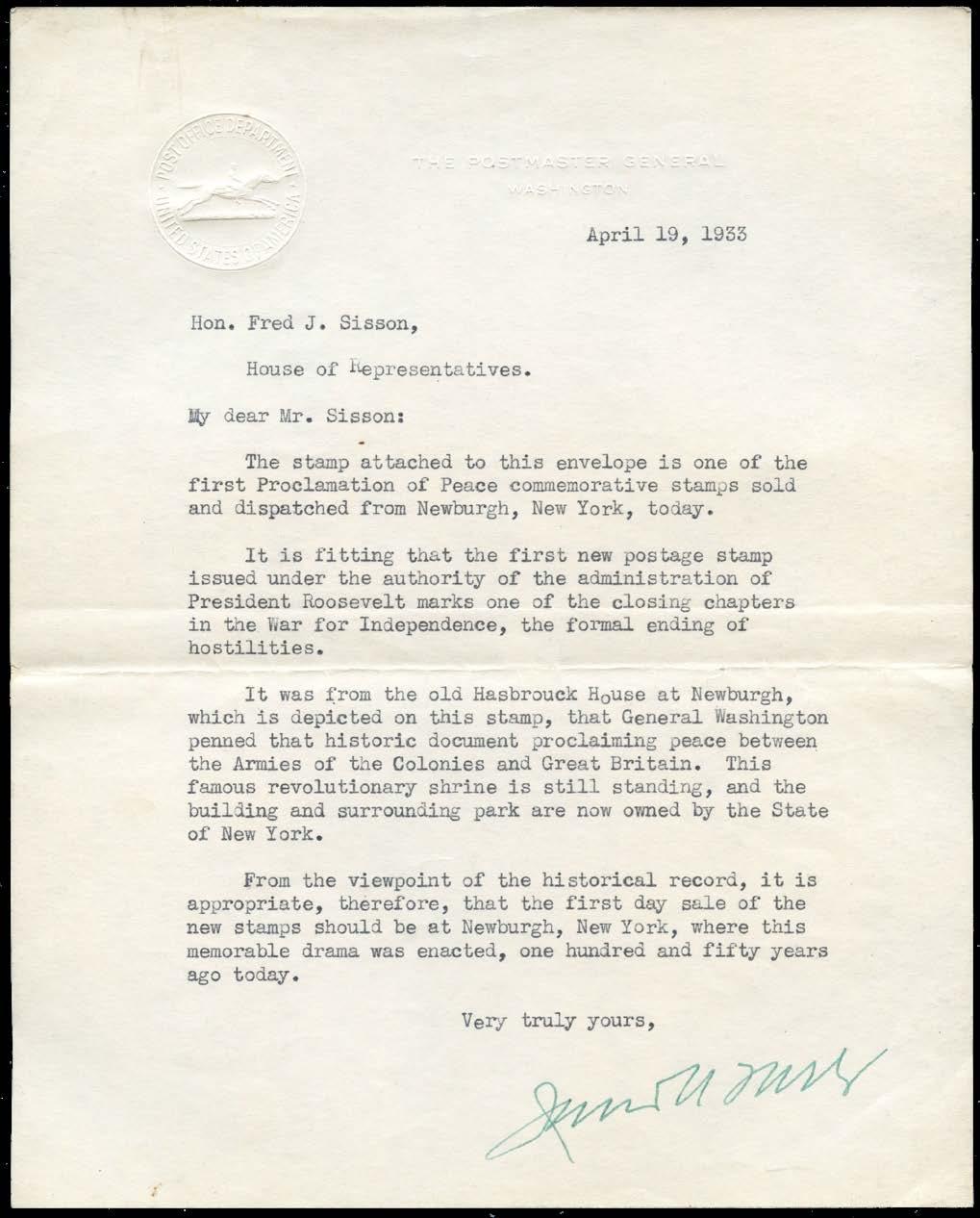

Figure 10. Favor FDC with Farley signed letter for the Newburgh Peace stamp.

Figure 11. Signed sheet of Newburgh Peace stamps from FDR’s collection (courtesy Franklin D. Roosevelt Presidential Library and Museum).
FDR also received first day covers sent by his admirers and fellow stamp collectors. One of my more unusual examples of this is shown in Figure 12. Only a month and a half into his presidency, this FDC is hand-addressed to FDR on the back of a photograph and franked with a strip of three Newburgh Peace stamps. It was sent “From your friend, Albert J. Walker” from San Antonio, Texas, who had apparently cut out a photograph of himself from 1917 wearing his World War I uniform, and pasted it next to the address. The black and white photograph on the other side shows yet another view of the Hasbrouck House on the Hudson River with a portrait of George Washington carefully cut from one of the current 3¢ postage stamps and pasted onto it. At the upper right are the words “Your first stamp, April 19, 1933,” and below this “Peace in 1783, New Deal—1933, with F.D.R.” At the bottom, the sender has written “Hon. Franklin D. Roosevelt—President U.S.A., Our New Deal President—1933.” Although replete with stamp hinge marks and tape remnants, the H. R. Harmer auction authentication handstamp shows that it was included in FDR’s stamp collection.
Another item from FDR’s “first hundred days” is the cacheted President’s Day cover franked with a Newburgh Peace stamp that was mailed on April 30, 1933. Shown in Figure 13, this was sponsored by the Pittsburgh Sun-Telegraph of the Hearst Newspaper chain, with a cachet reading “The nation joins in prayers of gratitude to Franklin Delano Roosevelt 32nd President of the United States for what he has already accomplished and for his continued health and success.” Curiously, one of the scarce rouletted “A Stamp Collector for President” labels produced by George W. Linn adorns the back,4 only the


third of these that I’ve seen used on cover. Analysis shows that this label came from plate position #1 on the printed sheet of 20.
Finally, in Figure 14, I show my cover sent to FDR by A. H. Benners of Birmingham, Alabama, on May 20, 1933. Franked by a horizontal pair of the Newburgh Peace stamps, the word “Stamps” is typed on the front. Research shows that Benners was a stamp collector who was actively involved in The Southern Philatelist, published by August Dietz, of Richmond, Virginia.5 Benners’ name is mentioned variously throughout, and it seems likely that Benners enclosed some stamps in this cover for FDR’s collection.
The first stamp issued by the new FDR administration, the Newburgh Peace stamp became the first of many. Also with this stamp, Farley began the novel practice of sending out first day covers on official PMG stationery to a favored few. These favor FDCs include
Figure 12. Unusual FDC for Newburgh Peace stamps sent to FDR on April 19, 1933.
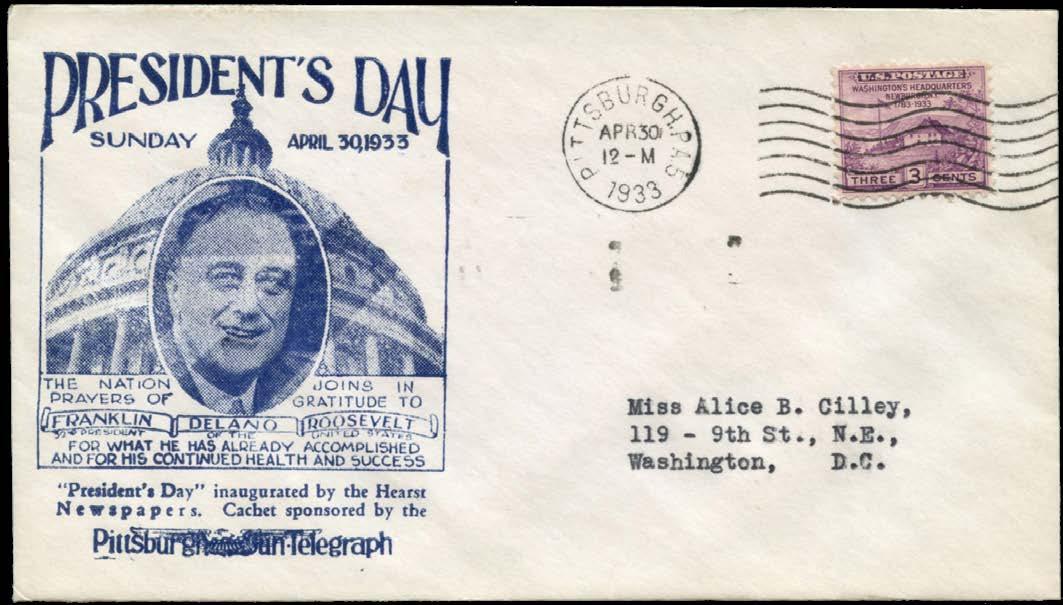
13. President’s Day cover franked with Newburgh Peace stamp with scarce rouletted “A Stamp Collector for President” label on back, mailed April 30, 1933.


signed letters by Farley describing the circumstances behind the issuance of the stamp, thus providing present-day philatelists with contemporary insight into the Post Office Department’s thoughts about each new stamp at the time it was issued.
Interestingly, it was the April 11, 1933, ceremony at the BEP during the first printing of Newburgh Peace stamps that inadvertently marked the beginning of the episode that came to be known as “Farley’s Follies,” when a number of full uncut press sheets of newly printed stamps were saved as special souvenirs for FDR and other favored individuals. When this situation became publicized, the resulting brouhaha caused Farley to have full press sheets of some twenty different stamps officially reprinted and sold (ungummed) to collectors at face value in March 1935. Such reprints of the Newburgh Peace stamps can be identified by the presence of intact press sheet gutters between stamps, as shown in my example block in Figure 15.
Figure
Figure 14. Cover with Newburgh Peace stamps sent to FDR on May 20, 1933.

Stamp collecting was an integral part of FDR’s life and perhaps his primary means of relaxation, so once he became President, this gave added scope to his strong interest in stamps and their design. Teamed with his Postmaster General James A. Farley, FDR helped to initiate a new era for stamp collectors in the United States, beginning with the Newburgh Peace stamp. Although this was in the depths of the Great Depression, stamp collecting offered an affordable hobby that was enhanced by having a popular President and avid stamp collector in the White House, helping to launch what many now consider the “Golden Age of Stamp Collecting.”
References
1. Max G. Johl, The United States Commemorative Postage Stamps of the Twentieth Century: Volume I, 1935–1947 (New York: H. L. Lindquist, 1947), 242–45.
2. The President Franklin D. Roosevelt Collection, Part One (New York: H. R. Harmer, Inc., February 1946), especially 23–24, 47, lots 65, 137, 142, and 292.
3. Paul M. Holland, “FDR and the 1935 Connecticut Tercentenary Stamp,” The United States Specialist, 91, no. 11 (November 2020): 489–95.
4. Paul M. Holland, “A Stamp Collector for President: George Linn, FDR and the 1932 Election,” The American Philatelist 130, no 5 (May 2016): 620–23.

The U.S. Philatelic Classics Society is a not-for-profit collector organization exclusively devoted to 19th century United States stamps and postal history. Our quarterly Chronicle is widely recognized for presenting new scholarship and discoveries. For membership information and much more, find us at: www.uspcs.org.
Figure 15. Ungummed block of the 1935 reprint of Newburgh Peace stamps showing gutter.


Ramon Magsaysay, Champion of Liberty
by Rodney A. Juell USSS #13852 | P.O. Box 3508, Joliet, IL 60434
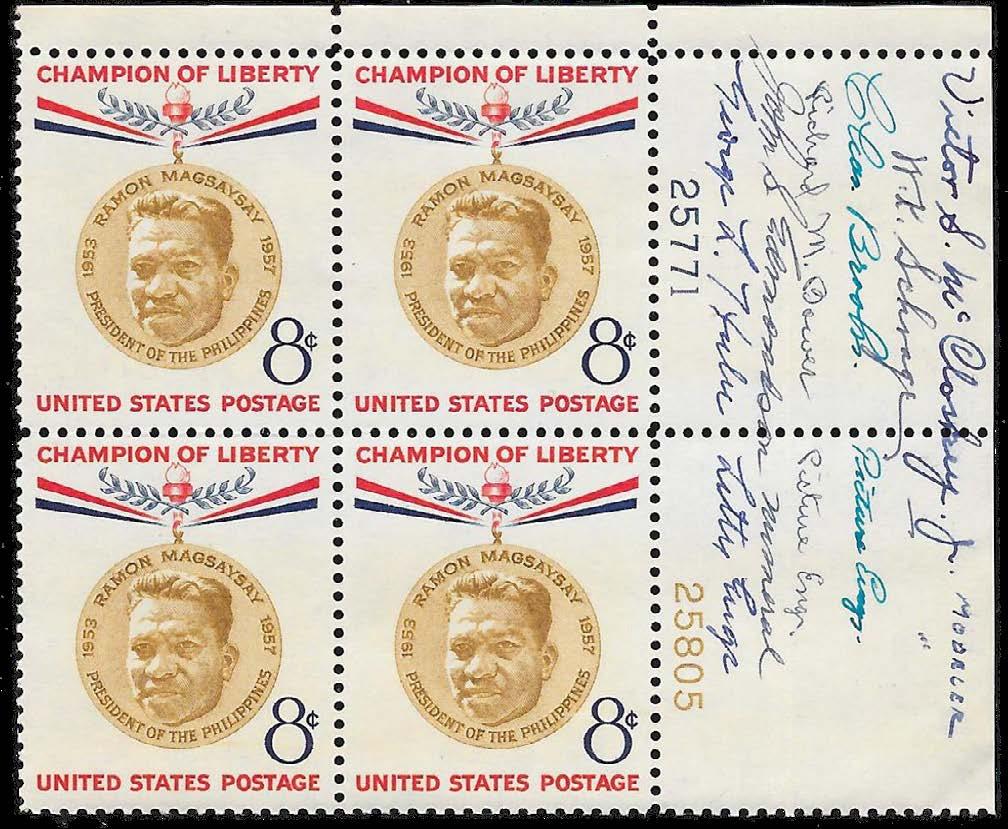
This month’s photo shows the dedication ceremony for the Ramon Magsaysay stamp, held on August 30, 1957, the day before the stamp was issued. President Eisenhower, who cut short a vacation in order to participate, is shown on the left. On the right is the Philippine ambassador. Between the two is Postmaster General Arthur Summerfield. The Magsaysay stamp was the first in a series known as the “Champions of Liberty” which celebrated various “champions of liberty” from around the world. A plate number block of the over-sized, Gioro Press stamp is shown nearby, signed by its modelers: Victor S. McCloskey and William Schrage, and its engravers: Charles Brooks, Richard Bower, John Edmondson and George Huber.
Vintage Photo of the Month



Re-Registered After Delivery Frankfurt, Germany to New York to Shanghai and Back
by Roger S. Brody USSS #11814 | m rsbco222@gmail.com

Phileas Fogg took 80 days to circumnavigate the globe, covering 19,130 miles, as described by Jules Vern in his 1872 novel “Around the World in 80 Days.” Thirty-five years later, it took three international postal services 134 days to dispatch and return the registered cover illustrated in Figure 1. The cover sent from Frankfurt, Germany, to New York, forward to Shanghai via San Francisco, and returned to Frankfurt via New York covered 24,780 nautical miles.
Figure 1. Registered cover: Frankfort, Germany to New York, to Shanghai via San Francisco, to Frankfort via New York.
Quite a journey indeed, but the most interesting feature of the registered cover is not the time in transit, distance covered, or destination post offices. The cover bears several markings associated with unclaimed returned mail, but the highlight is the seldom-seen “Re-Registered After Delivery” handstamp marking (Figure 2).

Figure 2. “Re-Registered After Delivery” handstamp.
The back of the letter (Figure 3) bore the manuscript “Sent by: Friedrich K.L. Dechent, 58 Niedenau, Franfurt a/M, Germany.”
The cover, addressed to Mr. Anatol Keil, c/o Messers Melchers & Co. account at Thos. Cook & Son’s New York office at 245 Broadway, was franked with a single 80-pfennig (pf) stamp cancelled with a double struck circular Frankfurt date stamp dated October 12, 1906. The stamp paid the triple 20pf per ½ oz letter rate and 20pf registration fee as attested to by the underlined script Einschreiben (Registered mail) and Frankfurt (Main) printed Eingeschrieben (Registered) No. 504 registry exchange label.

address.
Registry Exchange Labels
The production and use of exchange labels resulted from the implementation of a 1882 Universal Postal Union resolution requiring that international registered mail matter bear a label or impression of a stamp or label with a capital letter “R” usually in Roman text.
In the United States, the use of these labels by those post offices authorized to handle inbound and outbound foreign registered mail became effective on January 1, 1883, and
Figure 3. Registered cover back: forwarding, receiving markings and mailer’s return
stayed in effect, virtually unchanged, until January 24, 1911. Such postal facilities were designated “exchange offices,” and the labels have thus come to be known as “exchange labels.”
Research articles regarding these special-purpose labels have appeared from time to time in philatelic literature. The most comprehensive study of the production and characteristics of the various labels was done by Barbara Mueller. Her first article on the subject appeared in the October 1954 issue of The American Philatelist and was followed by a paper published in 1957 as part of The 23rd American Philatelic Congress Book Beginning in October 1972, she authored a series of seven articles that appeared in The United States Specialist entitled “U.S. Registry Labels—A Study of Types and Usages.” More recently, The Collectors Club Philatelist, the house organ of the Collectors Club of New York, published a two-part article by noted collector, author, and exhibitor Alfred L. Kugel.1
The Manuscript Instructive
The cover was received by the Registry office of the New York post office on October 21 and apparently delivered and accepted by the Thos. Cook company at their Broadway address. It is unknown why Keil never received the cover or if he ever was in New York. Cook attached their forwarding label, applying the manuscript forwarding instructions inked in the lower left of the cover, “If not called for until October 31–1906, please forward to Mess. Melchers & Co. Shanghai (China).” Apparently awaiting the arrival of Keil, the cover was not dispatched with registration until a month later, November 30.
Forwarding to Shanghai
Under Universal Postal Union regulations, forwarded mail did not require additional postage. Postal Laws & Regulations (PL&R) 1902, Title III Mail Matter, Sec. 531.4 provides:
Forwarding without prepayment: A mailable matter will be reforwarded without extra charge within the limits of the Union.
This was the case with the cover that reentered the Post Office Department (POD) mails in New York to be forwarded to Shanghai China. Thus, 60p of the 80-pfennig stamp paying the three times 20p per ½ oz letter rate applied and canceled in Frankfurt was sufficient prepayment to forward the letter on to Shanghai
Re-Registered After Delivery
Treatment of the registration fee for the forwarded letter was a different matter requiring additional postage. PL&R 1902, Title V. Registry System, Sec. 871, covers the forwarding and return of registered matter after delivery:
#1 When a registered article is properly delivered and receipted for its connection with the registry service ceases, and it must not be again received in the registered mails without prepayment of a new registry fee.
#2 If a new fee be paid, such an article may be forwarded, or returned, without additional charge for postage in every case where it might be so treated if it had not
been registered in the first instance. In such a case it must be reregistered, and a new registration receipt issued bearing the words “Reregistered after delivery.” The article must be likewise marked.
Apparently, the cover was accepted at the Thos. Cook office at 245 Broadway, requiring the addition of 8¢ US postage to re-register the cover with $25 Indemnity. This was achieved with the addition of four 2¢ Washington Shield sheet stamps with New York registry cancels and the “RE-REGISTERED AFTER DELIVERY” handstamp.
The letter was carried via rail to the exchange office in San Francisco and dispatched with the affixed Registry Label #66326 to Shanghai via ship.
What was Anatol Keil doing in Shanghai?
C. Melchers & Co., established in 1806 and headquartered in Bremen, Germany, was a private, owner-managed partnership operating in European and international markets. The company, operating in the fields of design, fashion, and textile production, provided product development and manufacture through sales, retailing, and marketing.
Melchers was one of the first European trading companies to open a branch in Hong Kong in 1866 (Figure 4). Helping manufacturers to market their products, and clients to buy or resell them, their business included importing and exporting to and from Asia and internal trading within Asia. By 1910 they were operating nine branches in China

4. Melchers Hong Kong Operations, 1910.
Return to Germany
The cover arrived at the US Postal Agency, Shanghai, on 12 January 1907 but was undeliverable to the addressee as noted by the “Unknown, Unclaimed and Return to Sender” handstamps on both front and back.
The cover was dispatched back to the sender in Frankfurt via the POD registry offices of the United States. As the letter was never delivered to the addressee in Shanghai, the
Figure
return under registration did not require additional postage. San Francisco received and forwarded the cover on February 8 to New York. The New York registry office received and forwarded the letter on February 13, applying the New York Registry Exchange label #12368.
Having twice traversed three continents, and two oceans, the cover arrived back at the Frankfurt post office on February 22, 1907, as noted by the double circle date stamp on the upper right of the cover back.
Transit Log
1. Oct 12, 1906 Franfurt, Germany / Registry Label #504 to New York
2. Oct 21 1906 New York Received
3. Nov 30, 1906 Forwarded New York to Shanghai via San Francisco
4. Dec 5, 1906 San Francisco / Registry Label #66326 to Shanghai
5. Jan 12, 1907 Shanghai, China Received
6. Unknown Unclaimed/ Return to Sender returned to Frankfurt
7. Feb 8, 1907 San Francisco, CA Received
8. Feb 10, 1907 New York Received
9. Feb 13, 1907 New York, NY / Registry Label #12368 to Frankfurt
10. Feb 22, 1907 Frankfurt, Germany Received
References
1. Nicholas A. Lombardi, “Registered Mail Study Group,” The United States Specialist 75 no. 1 (January 2004): 887.
Advertise in The United States Specialist
Deadline for ad copy is the 20th of the second month preceding the month of publication, as April 20 for the June issue. There is a 5% discount for payment in advance or with copy. To place an ad or for help with ad design, contact the Editor, Andrew Kelley, at (720) 839-5848 or editor@usstamps.org.

An Homage to a Forgotten Alaskan Aerophilatelist
by Michael L. Wilson USSS # 17371 | m mwilson34407@gmail.com

Figure 1. Cover franked with 3-cent Statue of Liberty coil (1954). Postmarked in Port Alexander, Alaska, on April 15, 1958, and backstamped (and front-stamped) April 30, 1958, in Port Alsworth, Alaska. Domestic air mail rate at the time: 6¢.
I purchased the cover shown in Figure 1 at the Great American Stamp Show in August 2024 in Hartford, Connecticut. I had never seen a cover like it and knew nothing about it—which is exactly what intrigued me. I love finding covers that spark curiosity and digging in to see what I can learn.
The cover has a cachet of a monoplane with the inscription, “This Envelope Carried by Airplane Within Alaska by United States Postal Star Route or Emergency Air Mail Service at Domestic 3¢ Rate from Town or Trading Post in Cancellation.”
Given the challenges—and in many cases, the impossibility—of traveling by road in Alaska, air service has long been the lifeblood of local communities. In fact, a series of air mail test flights was conducted in 1924 between Fairbanks and McGrath, a village about 275 miles southwest of Fairbanks.
Soon after, the United States Congress, recognizing the challenges of moving mail in Alaska, allowed the Postmaster General to contract for mail to be carried in Alaska by plane on an emergency basis or over established Star Routes, without the sender having to pay a premium.1 In other words, a first-class letter mailed within Alaska between 1932 and 1958—before statehood in 1959—could travel by plane for just three cents per ounce, compared to five to eight cents for standard airmail elsewhere.
The heyday of these emergency airmail or Star Route flights spanned the 1930s to the early 1940s, but these covers can be found all the way into the late 1950s. The definition of “emergency air mail” was somewhat fluid. The American Air Mail Society (AAMS) on its website notes, “Many of the so-called ‘emergency’ flights within Alaska were not emergencies at all, but simply the use of an airplane to forward mails because no other means was then available or the airplane offered the most expeditious delivery.” In addition, “postmasters were rather kind…to creators of Alaska air mail covers, often providing their signatures along with quality cancels.”2
It was the draw of collecting these covers that motivated someone by the name of “S. June” of Springfield, Massachusetts, to arrange in April 1958 for the postmaster of Port Alexander, Alaska, to post the cover shown in Figure 1 to Port Alsworth, Alaska.
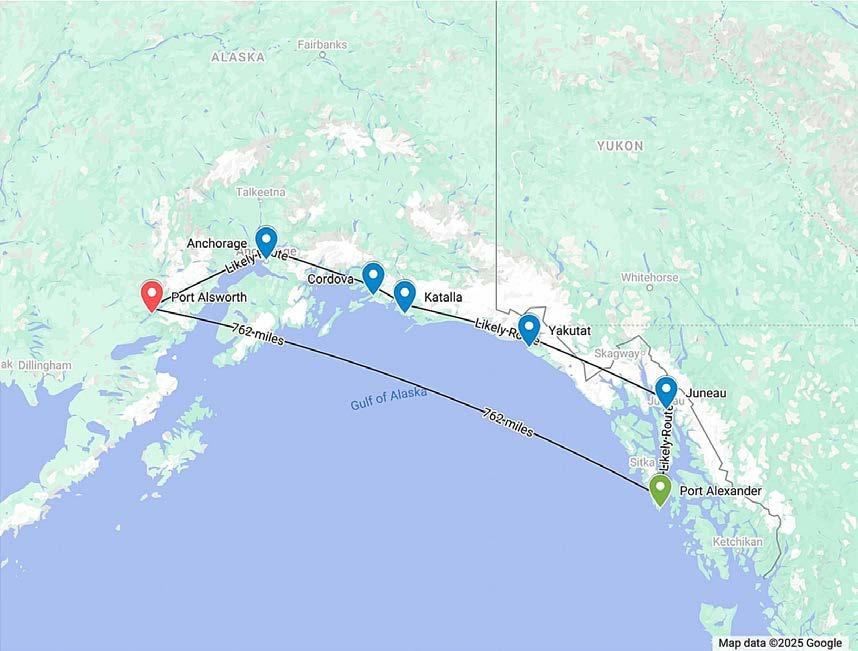
Figure 2. Distance between Port Alexander and Port Alsworth, Alaska and a possible route for the cover in Figure 1. (Google Maps, 2025)
Those two towns are 762 miles apart as the crow flies east to west over the Gulf of Alaska. Port Alexander is in the Alaskan “Panhandle,” and this cover likely traveled north to Juneau, then northwest to Anchorage, and finally southwest to Port Alsworth. That possible route is shown in Figure 2 and is based on Alaskan air mail routes included in The American Air Mail Catalogue (AAMC), Fifth Edition, Volume Five published in 1985. Since it was undeliverable in Port Alsworth, it was returned to P.O. Box 675 in Springfield, rented by “S. June.” When it arrived back is unknown.
That indirect route might explain why it took more than two weeks for this cover to arrive at its destination. Such a lengthy journey for an emergency air mail or Star



Figure 3. Three Alaskan flight covers prepared by S. June. Top: Franked with 3¢ Alaska Territorial (1937); postmarked September 22, 1938, in Iliamna, Alaska; mailed to Dillingham (136 miles by air). No receiving backstamp. Airmail rate: 6¢. Middle: Franked with 3¢ Defense (1940); postmarked April 7, 1941, in Barrow; mailed to Nome (519 miles by air); backstamped April 19, 1941. Airmail rate: 6¢. Bottom: Franked with 3¢ Alaska Territorial (1937); postmarked April 24, 1959, in Tatitlek; mailed to Cordova (49 miles by air); backstamped April 27, 1959. Airmail rate: 7¢.
Route flight cover was not unusual. These covers would travel from post office to post office, and if they spent a day or two at each location before moving on, the time would quickly add up.
In his 1993 article2 and another he co-authored for the Air Post Journal (APJ) in July 1994,3 noted Alaskan aerophilatelist Shaw reported that several Alaskan aerophilatelists prepared covers like those shown in Figure 1 between the 1930s and 1950s. He mentions just a few by name, the most prominent being August Koestler of Portland, Oregon.
Koestler was well known for collecting Alaskan flight covers and was mentioned frequently in the APJ during the 1930s and 1940s. Koestler checked The Postal Bulletin for flight routes and developed a rapport with postmasters throughout Alaska. Together with Jesse Johnson, Koestler published a catalog of Alaskan flight covers, titled Sourdough Flights, in 1941. Koestler’s listing first appeared as a series of articles in the late 1930s in the Western Stamp Collector and is the basis for the AAMC catalogue of Alaskan covers.
The other individual Shaw mentions is “S. June” or just “June.” Shaw wrote in 1993, “The rich variety of cachets that collectors created to grace the face of their ‘Emergency Air Mail’ covers deserves some attention. Many of these are recognized as personal signatures of early Alaskan aerophilatelists, with Koestler and June perhaps creating the most elaborate.”2
So, who was “S. June”? I found no references in the APJ or the David Straight Memorial Philatelic Union Catalog—aside from Shaw’s brief mention—but the covers themselves offered clues. I later acquired three more examples on eBay, dated 1938, 1941, and 1959 (Figure 3), confirming a long and consistent collecting interest.
My search for “S. June” became easier once I acquired more covers. Two have a return street address rather than a P.O. Box. Using that information, I searched historical records on Ancestry.com and matched the name and address to Stanley J. June of Springfield, Massachusetts.
Born in Easthampton in 1898, Stanley June lived most of his life in Springfield, working as an inspector for the Savage Arms Company. He never married and passed away in 1975. Beyond that, details are scarce—but through the covers he created, he left a lasting legacy.
And that’s it. I know when and where Stanley June was born and died, what he did for a living, his marital status, some basic physical features (from his draft card) and that he collected Alaska emergency air mail covers.
Though we may never know what drew Stanley June to Alaska or whether he belonged to any stamp clubs, his enthusiasm is clear. His covers—carefully prepared, correctly rated, and routed through remote Alaskan towns—speak to a collector’s curiosity and joy. For that, he deserves to be remembered.
Notes
1. Emergency air mail service was not limited to Alaska. Per the American Air Mail Society, special arrangements were made to carry mail by airplane “during emergencies such as floods, severe storms, breakdown of rail transportation, strikes, and other conditions requiring the abnormal dispatch of mail.”
2. Terry Shaw, “Airmail Covers of Territorial Alaska,” Airpost Journal, 64, no. 5 (May 1993): 233–37..
3. Bob Hunter and Terry Shaw, “The Early Airmail Flights of Alaska,” Airpost Journal, 65, no. 7 (July 1994): 294–95.

History of Philately
John Walter Scott: The Father of American Philately
by Chris King m Chris.King@postalhistory.net

Figure 1. Catalogue of an Exceedingly Choice and Select Collection of Postage Stamps, to be sold by Auction on Saturday Evening, May 28th, Commencing at 6 o’clock.
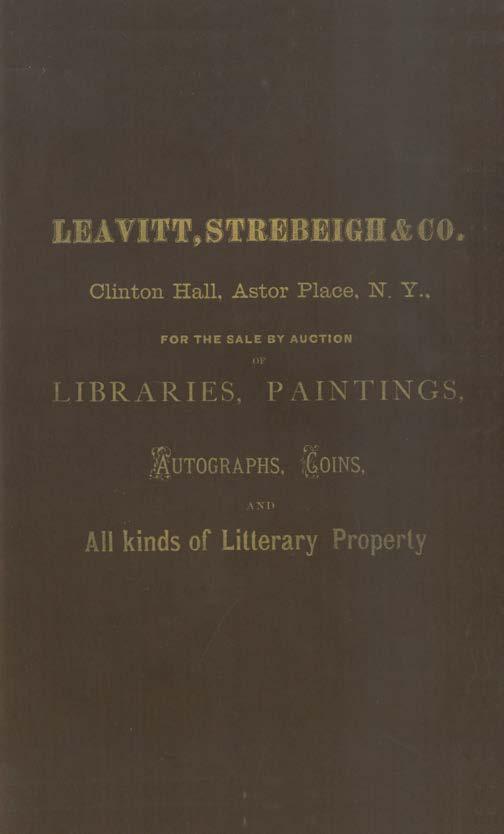
Figure 2. Leavitt, Strebeigh & Co, Clinton Hall, Astor Place, N. Y., for the Sale by Auction of Libraries, Paintings, Autographs, Coins, and All kinds of Litterary [sic] Property.
At six in the evening on May 28, 1870 at Clinton Hall, 21 Astor Place, New York, the philatelic world saw its first stamp auction. With 270 lots offered, John Walter Scott added a new dimension to the stamp dealing trade. The John Sacher Library was fortunate in recently receiving an original copy of the catalogue generously donated by James Podger FRPSL. This complements the Royal Philatelic Society London’s copy of the first London auction sale, also promoted by Scott, on March 18, 1872, at the premises of Sotheby, Wilkinson & Hodge in Wellington Street, off The Strand, in London.
So, who was J. W. Scott? It is important to remember that he never wrote his own biography, and that many early documents were lost in a fire at his print shop in 1878. Consequently, much of the printed record of Scott’s life is from secondary sources, and subject to the frailties of memory and opinion.
Early Life and Move to the United States
John Walter Scott, born in Walworth, London, on November 2, 1845, moving to the East End of London before his fifth birthday, and there is no evidence of his father in either the census of 1851 or 1861. His baptism certificate dated March 22, 1861 in the Parish of St. Dunstan, Stepney in the East End of London, reports his father John to have been a commercial traveler, deceased. The 1861 census records his mother, Martha Scott, as “Dependent on Funds.”
He began his career with little formal education and his interest in philately was kindled in 1860 while working as a young clerk in a London merchant’s office, where he was exposed to foreign stamps. He began to trade in stamps soon after, according to Stamp Collectors Fortnightly, No. 402 Vol. XVI, August 6, 1910, at the Stamp Exchange in Birchin Lane in the City of London, less than five minutes’ walk from the Royal Philatelic Society London’s offices in Abchurch Lane. Stamp Collector’s Magazine in its issue of February 1863 mentions the “Change in Birchin Lane and its alleys, where from fifty to a hundred individuals used to congregate in the evenings of last spring”—that is the spring of 1862. It’s likely that the young Scott was a “merchant’s clerk or office–boy, with an eye to business, having rummaged to some purpose for a packet of old letters …”, selling stamps to collectors in the street.
At the age of seventeen, he emigrated to the United States, leaving on July 27, 1863, and arriving in New York on the Heda with his modest stamp collection and his friend Charles Watson. Scott sold his stamps for $10 to a street dealer in Chambers Street, north of the City Hall Park. Soon afterwards he went back to his purchaser, and in conversation complained that he could not find work and said that he would join the army. The dealer offered to lend him $100 worth of stock to start in the stamp trade with a pitch next to his. He accepted, and after three months managed to save $100. It is not clear who gave Scott this helping hand, but William Penn Brown (1841–1929), possibly the second earliest dealer in New York, claimed to have given assistance. Selling stamps on the streets of New York, Scott laid the groundwork for what would eventually become an established philatelic business, aided by his sister Emily Florence Scott (born August 1, 1840) sending him Penny Blacks from England which he sold at 12 cents each.
Seeking success in California, Scott traveled overland to the gold fields in the Spring of 1865 but, like many others, was unsuccessful. Returning to New York via Sacramento and a shipwreck off Panama in 1867, he established a stamp company, at 34 Liberty Street, next to the City Hall Post Office. Trow’s New York Directory of 1868 includes Scott J.W. & Co. stamps at 34 Liberty (Street) on page 226. This was the J. W. Scott Company, Limited, which became Scott & Company from c.1875 until December 10, 1885, when Scott sold his business to Henry Collin, Gustave Bernhard Calman (December 6, 1860–January, 25, 1898) and Henry Lincoln Calman (August 22, 1863–October 3, 1935). They renamed it Scott Stamp & Coin Company. Scott retained a small interest in the business and


Figure 3. Preprinted form letter for Scott’s first stamp business dated October 30, 1869, to Charles S. Ordway (1854–1940) of Milwaukee, regretting the company’s inability to supply the stamps requested and returning the payment. On reverse an advertisement for Scott’s Albums, journal, and price list. Courtesy of John N. Lupia, III.
continued to work as editor of the catalogues and The American Journal of Philately until early 1889, when he sold off his remaining interest to start a new company in May 1889.
John W. Scott reopened his stamp business notwithstanding covenants in the agreement for the sale to the Calmans, and he announced his return to the trade with an advertisement in The American Philatelist of June 1889.
The Calmans, inevitably, sued Scott, but Scott’s right to engage in this new philatelic business venture was upheld by the Superior Court of the City of New York, which ruled that, “... Every man has the absolute right to use his own name in his own business, even though he may thereby interfere with and injure the business of another bearing the same name, provided …” (Scott Stamp and Coin Company, Limited v. The J. W. Scott Company, Limited. Decided November 5, 1890, Superior Court of the City of New York. New York Superior Court Reports, Vol. LVIII pp. 379–385. New York and Albany. Banks & Brothers, law publishers. 1891.)
It has not been possible to find exact dates of the establishment or the first registration of Scott’s three companies. This would add detail to the record, and better determine the chronology.

Figure 4. Advertisement in The American Philatelist, Volume III, No. 9, 10 June 1889.
Building the Philatelic Foundations of America
Beginning in June 1867, he began circulating monthly price lists. Scott later counted these single-sided leaflets as the first fifteen editions of his eponymous catalogue.
The price lists became The Scott Catalogue, which, officially published in September 1868 as its sixteenth edition with 20 pages as Descriptive Catalogue of American and Foreign Postage Stamps, Issued from 1840 to Date, Splendidly Illustrated with Colored Engravings and Containing the Current Value of each Variety, set a new standard for American philatelists by providing detailed information and standardized pricing—with standardized catalogue numbers established from 1887, although not by Scott, but by the new management under Calman. This catalogue is the red thread of American philately, binding the pioneers with the present and underpinning Scott’s impact. Since 1984, it has been produced by the Scott Publishing Company, a subsidiary of Amos Media which also publishes Linn’s Stamp News.
That same year, Scott helped to found the first New York Philatelic Society on January 19, 1868, and edited its journal, The American Journal of Philately, adding to his reputation and influence in the developing American philatelic community. Internal dissent led to the demise of the Society less than three years later, but Scott kept the journal.
Philatelic Publications and Auctions
Scott’s ambition led to fierce competition with the Boston philatelic community, spearheaded by Ferdinand Marie Trifet (September 10, 1848–September 26, 1899), who began publishing The American Stamp Mercury on 5 October 1867. Their rivalry— Trifet was 20 years of age, and Scott just 22—reflected the growing factionalism within American philately, but Scott persevered. His journal survived beyond Trifet’s publication which closed after 39 issues in March 1871, establishing Scott as a prominent figure in American philately. The American Journal of Philately launched in December 1868, ran for
184 numbers in twenty volumes until 1886 under Scott’s editorship, and continued for a further 228 under the editorship of Henry L. Calman, John Luff (November 16, 1860–August 23, 1938) and the Scott Stamp and Coin Co, ceasing in 1906.
Scott’s contributions were extensive: he introduced affordable stamp packets priced from 25¢ cents to $10, produced his own stamp albums from July 1868, and continued expanding Scott’s Catalogue . His innovation in auctioning stamps advanced the stamp trade, attracting broader public interest and setting new standards for the field. Through The American Journal of Philately, Scott promoted philately as a structured, serious enterprise, enhancing visibility and legitimacy. His albums and catalogues offered collectors consistent, high-quality resources, which fostered a standardized approach to collecting across the United States.

Figure 5. Scott’s retail premises at 146 Fulton Street, New York where the company had relocated from 75 and 77 Nassau Street in 1876. American Journal of Philately, Vol. XIV, October 1880. In the window of the shop there was a large sign stating, “The collecting of postage stamps is the most intellectual and agreeable pursuit of the day and is engaged in by old and young, rich and poor, prince and peasant. There are nearly 1,000,000 collectors in the U.S. alone, while amateurs are to be found in every civilized city, town or village in the world. It teaches geography and history, it developes a taste for art and science, and stimulates research in every branch of learning.”
In 1871, Scott sought to extend his influence to Great Britain, launching a British edition of The American Journal of Philately. This is volume V, numbers 49–60. Despite his efforts to collaborate with prominent British, and American born, philatelist Edward Loines Pemberton (December 10, 1844–December 12, 1878), Scott’s London edition was poorly received and faced criticism from the British philatelic establishment. Nevertheless, Scott persisted, and on March 18, 1872 he organized Britain’s, and probably Europe’s, first public stamp auction at Sotheby’s, marking a milestone in British philately.
According to Fred J. Melville, writing in The Philatelic Journal of Great Britain, October 1922, p.188., Pemberton attended the sale and bought a number of items “… and would have bought more but for the general feeling of distrust created by the owner (Scott) running up the prices himself instead of following the customary English method of placing reserves upon the lots. … Some of the items E. L. P. secured are, however, of interest. He paid £5 for a “Jefferson Market P.O. pink, unique,” a rare local which exists on pink and on blue paper. Melville quotes The Philatelical Journal of April 15, 1872 which

has an extended and critical report of the auction, “Here occurred something amusing, the auctioneer probably fancied that, as this was unique and exciting competition, it was a handsome stamp, so as the bidding rose, described it as ‘beautifully engraved’, which created great laughter, for it was a foully hideous thing, and the engraving apparently done by a blind man with a skewer.” He adds that, “Most of the U.S. locals sold fell to Sir Daniel Cooper [July 1, 1821–5 June 1902], Mr. Atlee [William Dudley Atlee 1848–c.1890], or Mr. Pemberton, but the greater number were bought in by the owner. Pemberton secured three fine unused Sydneys and a poor 3d. unused for 63/-, which he reckoned were ‘decidedly the only bargain in the sale so far.’”
Philatelic Societies and Exhibitions
Beyond commercial pursuits, Scott was instrumental in cultivating a philatelic community. He played a founding role in establishing the American Philatelic Society (APS), serving as president from 1917 until his death in 1919. He was also a founding member of the Collectors Club of New York in 1896, an institution that provided resources and organized exhibitions, elevating philately’s cultural standing. The last three years of his life were spent daily at the Collectors Club where he served as librarian.
He was the only philatelist who exhibited stamps at the 1876 Centennial exhibition in Philadelphia and served as Chairman of the famous Eden Musée New York Philatelic Exhibition, during March–April 1889 organized by the Brooklyn, Staten Island and National Philatelical societies. He also compiled the catalogue. Later, Scott was Treasurer of the New York International Exhibition of 1913.
Figure 6. Scott’s retail premises at Fulton Street, New York. American Journal of Philately, Vol. XV, January 1881.

Figure 7. John Walter Scott said to be pictured in 1877. From Looking Backward, Or Fragments From a Checkered Life; My Life Story, J. E. Handshaw 1923. James Elbert Handshaw (1855–1926) bought John W. Scott & Company, Limited in 1916. A very similar image appears in The Record and Review, the journal of Albert R. Rogers, New York, NY, USA, December 1890, Volume 1, Issue 3, p.33–34, stating that the image is of Scott aged 45.
Personal Life
Scott married Minnie Peyton (c.1844–November 19, 1936) on October 15, 1868 and had six children. He was well-known for his moderate lifestyle, remaining in good health throughout his career. As a committed vegetarian for over thirty years, he served as president of the New York Vegetarian Society, promoting vegetarianism and a minimalist lifestyle.
His Death
He died unexpectedly on January 4, 1919, while serving as APS president and was posthumously inducted into the APS Hall of Fame in 1941. The continuance of the Scott Catalogue continues to mark his pioneering work and his pivotal role in American philately. Through his vision and efforts, Scott transformed American stamp collecting from a niche hobby into an organized and respected enterprise, ensuring his place in the pantheon of philatelic greats.
Legacy in Philately
Scott’s pioneering efforts were instrumental in shaping philately in the United States. By establishing an influential stamp catalogue, advancing public auctions, and fostering philatelic societies, Scott formalized philately as a respected pursuit. The Scott Catalogue remains an important reference, commemorating his life in American philately.
Over his five decade career, Scott organized 120 auctions, including in 1882, the first to include photographic illustrations, and the first to feature stamps valued over $1,000. With a journal, a catalogue to collect by, and albums to house a collection, Scott created both a demand for philatelic material and provided the means of satisfying that demand, ranging from packets and moderately priced material to classic rarities for the advanced and wealthy collector. Scott’s legacy was the philatelic world of the twentieth century, and its echoes remain today.
In His Own Words
In 1895 Scott began his series of Weekly News Letters advertised as limited to one hundred copies. “A private and confidential communication to the one hundred leading amateurs in America.” This series, distributed from September 25, 1895 to May 2, 1897, Nos. 1–84, is rare. Scott in his own words is instructive and entertaining.

Figure 8. John Walter Scott, Stamp Collectors’ Fortnightly, 6 August 1910, Volume 16, p.101.

Figure 9. John Walter Scott in 1919, according to J. B. Chittenden, John Walter Scott; Collectors Club Philatelist Vol. II, October 1923: p. 126. Cover photograph in Philatelic West, Vol. 75, No. 3 (May 1919) with no reference to source. Portrait by Emile Brunel (1874–1944), founder of the Brunel School of Photography, now New York Institute of Photography.
January 15th, 1896.
Considerable attention is now being given to the formation of Philatelic libraries and I venture to predict that in the future enormous prices will be paid for rare works having any merit; already very large figures are realized for the better class of old magazines, two different volumes of the old series of American Journal of Philately are a ready sale at $25 each and a soiled unbound volume of the American Stamp Mercury realized $9 at our last sale. Priced Auction catalogues are of very great interest and should command the very highest prices, there are probably only two complete files in the world, and these are owned by two gentlemen who have scarcely missed a sale since I inaugurated the auction business some quarter of a century ago. Complete libraries of all stamp publications are probably possessed by only two, Messrs. Tiffany and Deats, and future generations will be much indebted to these two gentlemen for their painstaking work. Their libraries have cost much money, but they could doubtless be sold at an enormous profit.
July 18th, 1896.
In the course of a speech at the annual dinner of the London Philatelic Society Mr. M. P. Castle stated that the stamp fraternity might be classified on zoological lines into birds, beasts, fishes, and reptiles. The birds being collectors pure and simple who filled their albums for the love of the pursuit and above all sordid considerations; the fishes were the collectors who bought and sold, picked up bargains and belonged to exchange clubs, etc.; the beasts were the dealers who prey on the birds and fishes when they can catch them; while the reptiles were the speculators who neither toiled nor spun, but only held in barns waiting for a rise. The aptness of the illustration is acknowledged by all and has been widely

Figure 10. Photograph of John Walter Scott from the American Journal of Philately, Volume X, January 20–December 20, 1878. The copy held by the John Sacher Library at the Royal Philatelic Society London includes this image facing the title page.
quoted. I may add that from general appearances this must be the cretaceous age, as reptiles are very plentiful, and birds seldom seen.
August 1st, 1896.
As the auction season will soon be opening a few words on the subject may not be out of place, more especially as some ugly rumors in regard to the way some of our contemporaries have conducted sales entrusted to their care have been circulated, while other dealers who have never even risen to the place where they might reasonably expect to get the sale of a collection are continually decrying auction sales as being one of the chief causes of the depression of the stamp business and fervently hoping that there will not be many sales this season. I established the custom of selling stamps at auction, not to benefit my own trade but for the security of collectors and to convince them that their property had a value, and demonstrated to their satisfaction that they could always dispose of valuable stamps without taking them to a dealer and accepting any price he might feel inclined to offer. It took many years’ work to get this fact firmly established, but I succeeded at last and now stamp collecting without auctions would be like a performance of Hamlet with the part of the melancholy prince left out. The English were even slower than our own people to take to auctions although I went to considerable expense in selling a collection in London to give them ocular proof of its benefits as an adjunct to high–grade collecting, however, after several years deliberation they caught on and have been running at high pressure ever since.
January 9th, 1897.
Auction sales will prove of even greater benefit to the collector than ever before, there being a movement on foot by some dealers to agree not to purchase at auction. This is done with the hope of limiting the number of sales, which are cutting deeply into the average dealer’s profits. Perhaps the truest dictum of political economy is that combinations for the restraint of commerce are futile, and certainly the combination of short–sighted dealers to compel amateurs to purchase their wares, will come to naught and collectors will reap the full benefit of auction sales. This is a subject on which I may be pardoned if I think I am competent to speak, as I sold the first stamp ever put up at auction and was the first to introduce the stamp auction in England. My purpose in establishing auction sales was to give stability to the stamp business. l never calculated that it would benefit me or any other directly, quite the reverse. My object was to show collectors and the world at large that stamps had a saleable value and that after a man had accumulated a valuable collection he could place his album in the hands of the auctioneer and rely upon his fellow collectors to buy his stamps at a fair price, instead of being compelled to take his treasures to a dealer and accept whatever sum might be offered. I can truthfully say that during my thirty–five years’ career as a dealer
I have always acted for the best interests of my customers and what is more I have never had occasion to regret it.
This article draws on Dr. J. Brace Chittenden’s research on Scott’s legacy, published in the Collectors Club Philatelist. Dr. Jonathan Brace Chittenden (August 24, 1864–March 20, 1928) was President of the Collectors Club New York from 1911 to 1912 and again in 1920.
Originally published in The London Philatelist, Volume 134, Whole Number 1522, pp. 8–15 in January-February 2025, and reproduced with the kind permission of The Royal Philatelic Society London. Updated and corrected by the author, February 18, 2025.
With thanks for assistance from the John Sacher Library at the Royal Philatelic Society London, The Smithsonian National Postal Museum, Jay Bigalke FRPSL , Brian Birch FRPSL, Carol Bommarito FRPSL, Roger Brody RDP FRPSL , Lawrence Haber FRPSL , John N Lupia III of New Jersey, Vincent Schouberechts FRPSL and Wolfgang Maassen
RDP FRPSL.
References
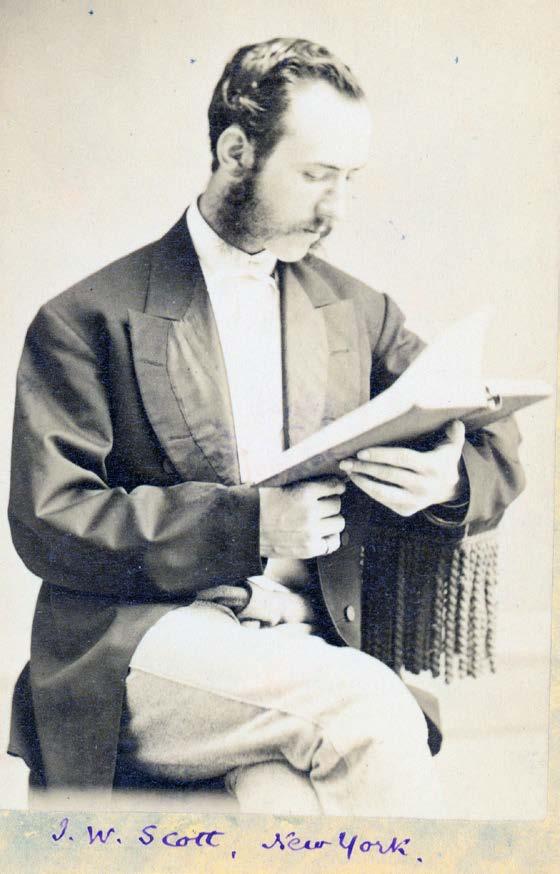
Figure 11. John Walter Scott, as published on the front cover of the Bay State Philatelist, January 1896, Volume 1, Issue 8.
1. The Record and Review, the journal of Albert R. Rogers, New York, NY, USA, December 1890, Volume 1, Issue 3: p.33–34.
2. Chittenden, Dr Jonathan Brace, John Walter Scott; Vol. II, October 1923: pp. 126–141.
3. Chittenden, Dr Jonathan Brace, Scott in Philatelic Organizations; Vol. III, April 1924: pp. 65–73.
4. Chittenden, Dr Jonathan Brace, Scott in Phialtelic [sic] Literature; Vol. III, July 1924: pp. 119–124.
5. Chittenden, Dr Jonathan Brace, Scott and the Exhibitions; Vol. III, October 1924: pp. 160–164.
6. Handshaw, J. E., Supplement to Metropolitan Philatelist; 13 January 1919.
7. Bierman, Stanley M. M. D., J. W. Scott Sales 1870–1919; Philatelic Literature Review, Vol. 35, No. 4, 1986: pp. 113–136.
8. Birch, Brian J., Biographies of Philatelists and Dealers, 21 February 2018.

Report of the Executive Secretary
APPLICATIONS RECEIVED FOR JUNE 2025
17619 Michael Borrelli, Little Rock, AR
17620 Thomas Altshuler, Erie, CO
17621 Ronald Sturdivant, Greensboro, NC
APPLICATIONS PENDING
17615–17618
17610–17614
USSS Membership Recruiting! Some members have commented they were pleased to see a Membership Application form included in recent issues of The Specialist. At The Great American Stamp Show every year we hand out promotional copies of back issues of The Specialist and separately, a membership application form. We know these copies are widely circulated. Make a USSS “New Years Resolution” and promote USSS membership! Any membership questions? E-Mail Bob Rufe: execsecretary@usstamps.org






3 #???? Flag

3 #???? Flag coil B11111

3 #???? Flag coil

3 #???? Flag coil Spaced P1111
COORDINATORS: Members are invited to report their findings to the appropriate coordinator.
All issues through 1980

Kim D. Johnson
310 E N 3rd Street
Georgetown, IL 61846 Sheet stamps after 1980
Jim Cochrane P.O. Box 2009 Great Bend, KS 67530
Coil stamps after 1980 Jill Ambrose PO Box 54622 Cincinnati, OH 45254
Booklet stamps after 1980 Michael O. Perry P.O. Box 1194 Rainier, OR 97048
This monthly report is used to update the Durland Standard Plate Number Catalog.
Classified Advertising
USSS MEMBERS are entitled to two free ads of up to 40 words each year. Other ads are 10¢ a word, payable in advance. For 6 insertions, take a 5% discount; for 12 insertions, take a 10% discount. Ads with [1146] at the end expire with this issue. Make checks payable to USSS. Send copy and check to The United States Specialist, 9038 E. 25th Dr., Denver CO 80238. Free member ads may be emailed to: editor@usstamps.org. Emailing ads saves substantial time for you and the Editor and avoids errors .
WANTED
BUYING IMPERF FARLEYS with GUM. ALL offers welcome! Frank P Geiger Senior - APS Life since 1968 and ASDA since 1974. Phone: 787-6896879–FrankPGeigerSr@gmail.com–PO Box 3442–Pinehurst, NC 28374. [1150]
WANTED—PAYING TOP DOLLAR FOR C-13, C-14 and C-15 singles, both mint/used. Also interested in multiples, flight covers, Zeppelin-related posters, advertisements, etc. Graf Zeppelin specialist. Rob Lehmann email: diecasttoys@yahoo.com or call: 240422-0118. [1150]
WANTED TO PURCHASE #1053 HAMILTON $5 Commercial Usages. Especially need use to foreign destination. Also doing a survey so scans appreciated. Doug Weisz weiszcovers@gmail.com, 773-9144332. 33 W Ontario St. #48A Chicago IL 60654. www.douglasweisz.com [1152]
SEEKING USS INDEPENDENCE STAMP similar to Scott #4703 USS Constitution stamp. Bernard Wojnowski; 64 Mariner Rd., Vineyard Haven, MA 02568. [1155]
SPECIALIST SEEKING OWNERS OF 10-cent Motorcycle Special Delivery die proofs or 11-cent Rutherford B. Hayes die proofs for research. Email Jerry: jerryakatz@aol.com [1146]
WANTED - SPECIFIC BOOKLET PANE PLATE
Numbers and Positions on Scott Nos. 331a through 554c. Want List available via snail mail or email—Bob Rufe, rrufe1@aol.com Box 1602, Hockessin DE 197075602 [1147]
WANTED TO BUY: HARCO SLOGAN PLATE
Block Files. Soft covers, new or gently used. Size: Approx. 11 × 51/4. E-mail photos and price to Glen: gnsitgh@aol.com [1147]
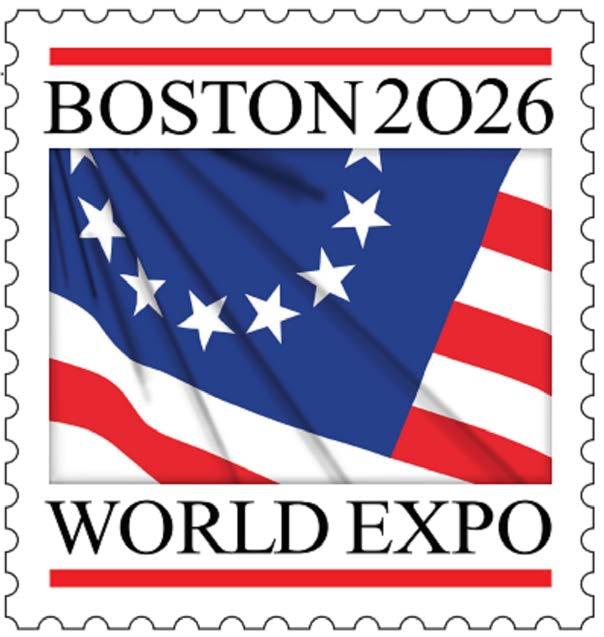
Precancel Stamp Society
Interested in Learning More about Precancels? Request a copy of “Th e ABCs of Precancel Collecting” and also receive a sample copy of the PSS Forum, the Precancel Stamp Society’s monthly journal. Contact: Frank Bird III, 1095 Pinellas Point Dr South, Apt 352, St. Petersburg, FL 33705-6377. Email: promo@precancels.com.
Index of Advertisers
Armen Hovsepian (www.USatFACE.com)........................................
346 Boston 2026
(www.boston2026.org) .......................................
384
Lewis Kaufman (kerik1@aol.com) 347
Mountainside Stamps, Coins and Currency (www.mountainsidestampsandcoins.com) ....... 346
Precancel Stamp Society (www.precancels.com)......................................... 384
Richard Friedberg (www.friedbergstamps.com). 347
Robert A. Siegel Auction Galleries (www.siegelauctions.com) ................................... 339
Scott A. Shaulis (www.shaulisstamps.com) 346
U.S. Philatelic Classics Society (www.uspcs.org) .................................................... 359
United States Stamp Society (www.usstamps.org) 366, Covers
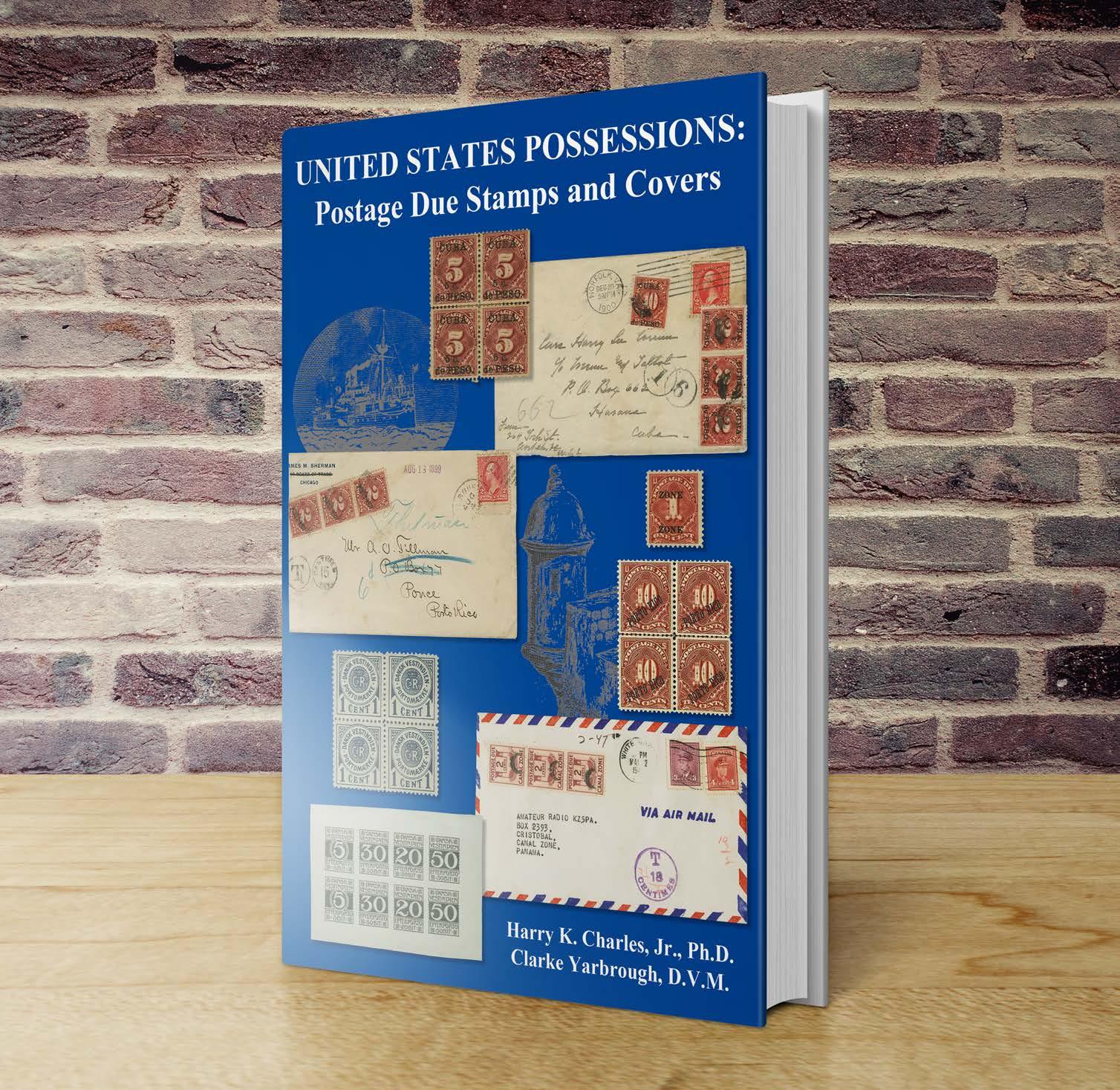
United States Possessions: Postage Due Stamps and Covers presents the story of Postage Due stamps used in the major possessions or territories of the United States. Written from a stamp collector’s perspective, the authors address the challenge of identifying the myriad of Possession Postage Due stamps by concentrating on stamp identification while also covering the Postage Due issues of Cuba, the Danish West Indies, Puerto Rico, the Panama Canal Zone, the Philippines and more.
In addition to the text, the monograph contains over 300 illustrations and five appendices which provide information to supplement and further explain key points. In many cases, the information presented is new or, if previously reported, organized in a new manner to help the reader understand the complexity of the Possession Postage Dues.
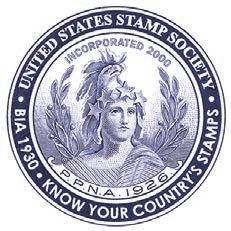
United States Possessions: Postage Due Stamps and Covers
Hard cover, 352 pages, 6-in × 9-in.
Member Price: $39 US postpaid Non-Member Price: $43 US postpaid Purchased online at: www.usstamps.org/store/ or by mail to: Executive Secretary, P.O. Box 1602, Hockessin, DE 19707-5602

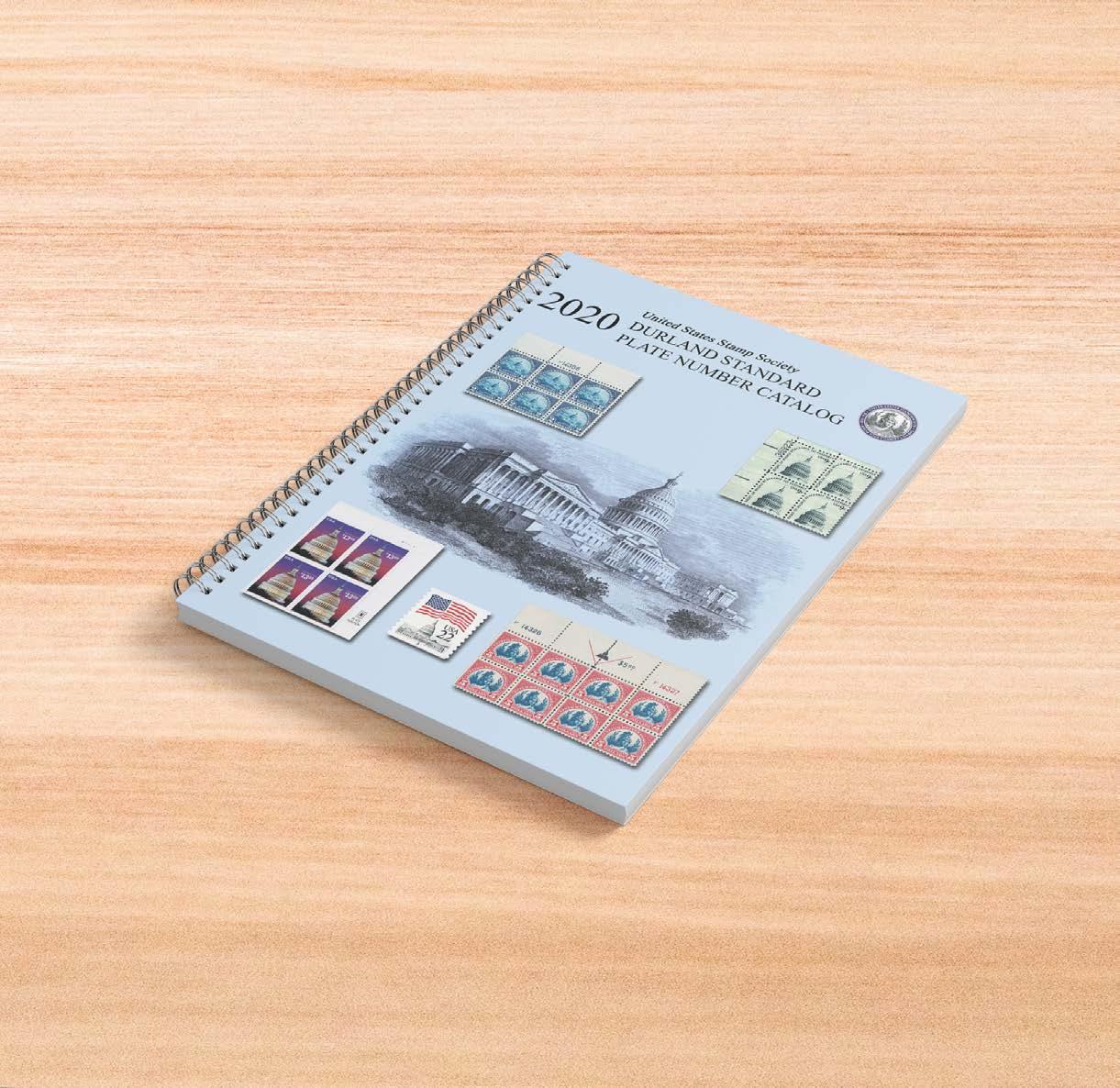
United States Stamp Society
The 2020 edition the Durland Standard Plate Number Catalog provides the most comprehensive research source for plate number information on United States postage and revenue stamps, including tax-paid revenue stamps, with listings for overprinted Possessions postage, Allied Military government stamps and other back-of-the-book stamps, dummy and test stamps, MDI "Blue Cover" booklets and partial plate numbers on booklet and coil stamps.
2020 Edition of the Durland Standard Plate Number Catalog 448 pages available in Spiral Bound format.
Member Price: $40 US plus shipping Non-Member Price: $45 US plus shipping
Order Online at: www.usstamps.org/store
